“Tidbits of History”
This section devotes itself to the tiniest history trivia of our area at random; enjoy your time travel trip……..
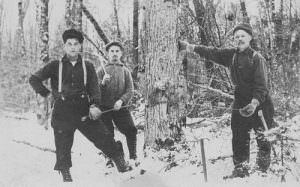 During the lumbering era, many lumberjacks made the Snyder House hotel their summer headquarters. Quoting the Republican-News & St. Ignace Enterprise in 1939: (the hotel)…”whose portals were crossed by such immortals as “Ruffian O’Brien”, “Black Jack”, “Protestant Ben”, “Brigham Young”, “Pat Belleville” and many another whose sobriquet was famous in the camps of bygone years; the Mackinaw Lumber Co.’s operations; the old Black River crowd; the influx from Roscommon & those who came from AuSable; the old timers who accompanied “Mackinaw Tom” & Bill Ross and Alger-Smith outfit on the Fox & headwaters of the Manistique; the workers on the Carp and the Pine; the Two Heart, and the Indian, and those who wended their way farther west.” For 30 years, the hotel was operated by that old Civil War veteran Col. Simeon Snyder. After his death in 1917, his son Dewey, who first waited table in the hotel at age 12 years, operated the place until 1925, when it was closed for good.
During the lumbering era, many lumberjacks made the Snyder House hotel their summer headquarters. Quoting the Republican-News & St. Ignace Enterprise in 1939: (the hotel)…”whose portals were crossed by such immortals as “Ruffian O’Brien”, “Black Jack”, “Protestant Ben”, “Brigham Young”, “Pat Belleville” and many another whose sobriquet was famous in the camps of bygone years; the Mackinaw Lumber Co.’s operations; the old Black River crowd; the influx from Roscommon & those who came from AuSable; the old timers who accompanied “Mackinaw Tom” & Bill Ross and Alger-Smith outfit on the Fox & headwaters of the Manistique; the workers on the Carp and the Pine; the Two Heart, and the Indian, and those who wended their way farther west.” For 30 years, the hotel was operated by that old Civil War veteran Col. Simeon Snyder. After his death in 1917, his son Dewey, who first waited table in the hotel at age 12 years, operated the place until 1925, when it was closed for good.
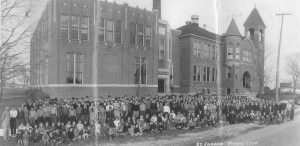 LaSalle School, with 11 grades, was built at the corner of Spring and Chambers Strets in 1888. By1908, one high school grade had been added. This school had no gymnasium nor auditorium until 1930, when an addition was built. The class of ’62 was the last to graduates from here, with the new school opening on Por4tage Street in the Fall of 1962.
LaSalle School, with 11 grades, was built at the corner of Spring and Chambers Strets in 1888. By1908, one high school grade had been added. This school had no gymnasium nor auditorium until 1930, when an addition was built. The class of ’62 was the last to graduates from here, with the new school opening on Por4tage Street in the Fall of 1962.
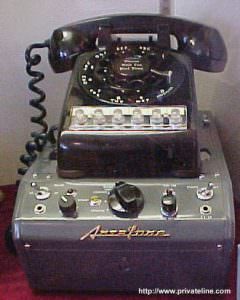 By August 1953, Dr. L.C. Shaftoe had installed “an automatic machine which records phone messages” in his absence. This machine which “is a type of wire recorder adapted by the telephone company”, was installed in his office. A patient could call number 255 and hear an explanation of his absence and a request that a message be left. Then, upon his return, the doctor could play it back!
By August 1953, Dr. L.C. Shaftoe had installed “an automatic machine which records phone messages” in his absence. This machine which “is a type of wire recorder adapted by the telephone company”, was installed in his office. A patient could call number 255 and hear an explanation of his absence and a request that a message be left. Then, upon his return, the doctor could play it back!
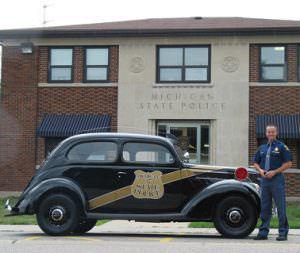 The first State Trooper assigned to St. Ignace was Ralph Sheehan in 1932. These early Michigan State Police troops worked out of the county sheriff’s office. Later, they established headquarters at the old City Hall. The State Police Post was built on State Street in 1937, on land donated by Mackinac County, with the U.S. government contributing heavily to the building costs. The first commander there was Sgt. Fred M. Keune. In 1993, the troopers moved to a new site at the north end of the Mackinac Bridge.
The first State Trooper assigned to St. Ignace was Ralph Sheehan in 1932. These early Michigan State Police troops worked out of the county sheriff’s office. Later, they established headquarters at the old City Hall. The State Police Post was built on State Street in 1937, on land donated by Mackinac County, with the U.S. government contributing heavily to the building costs. The first commander there was Sgt. Fred M. Keune. In 1993, the troopers moved to a new site at the north end of the Mackinac Bridge.
 In 1910, a brick and tile making plant was constructed along the DSS&A tracks about 3 miles out of St. Ignace. It was expected to make 25,000 bricks a day to start, with 40,000 per day at full capacity. The work crew needed would be 25 to 40 men. In February, manager Ed Reavie invited 20 local businessmen out for a tour. Many orders were already in, for delivery to Marquette, Houghton, Calumet, “the Soo”, Laurium and Hancock. Bricks will range from cream to brown, “according to the burning given”. Both common and pressed bricks will be offered. This tract is 40 acres of clay beds, sufficient to stock the kilns for 40 years. DSS&A provided a 1000 foot long switch which traverses the land from end to end.
In 1910, a brick and tile making plant was constructed along the DSS&A tracks about 3 miles out of St. Ignace. It was expected to make 25,000 bricks a day to start, with 40,000 per day at full capacity. The work crew needed would be 25 to 40 men. In February, manager Ed Reavie invited 20 local businessmen out for a tour. Many orders were already in, for delivery to Marquette, Houghton, Calumet, “the Soo”, Laurium and Hancock. Bricks will range from cream to brown, “according to the burning given”. Both common and pressed bricks will be offered. This tract is 40 acres of clay beds, sufficient to stock the kilns for 40 years. DSS&A provided a 1000 foot long switch which traverses the land from end to end.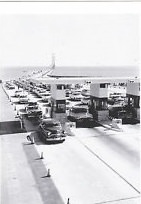 Pictured here is the Mackinac Bridge’s official opening day-November 1, 1957. Governor G. Mennen Williams paid the first fare-$3.25. The toll plaza originally included five booths which accommodated six lanes of traffic. The Mackinac Authority Building is faced with Drummond dolomite stone.
Pictured here is the Mackinac Bridge’s official opening day-November 1, 1957. Governor G. Mennen Williams paid the first fare-$3.25. The toll plaza originally included five booths which accommodated six lanes of traffic. The Mackinac Authority Building is faced with Drummond dolomite stone.
Frank Skinner Walker (1852-1922) was one of the youngest boys to enlist as a Union bugler-at the age of 11! He served with the New York 15th Cavalry for two years, until the end of the Civil War. Working as a machinist in New York and Ohio for a time, by 1883 he was in St. Ignace. He turned to the furniture and undertaking business here, with his father-in-law. This business was his career for the rest of his life. He also served as coroner for many years. At the time of his death, he was City Clerk and President of the Board of Education. He was also a Mason, a Knights Templar and was a member of the Odd Fellows and Knights of Pythias.
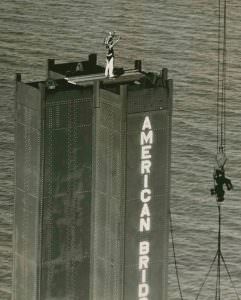 In September 1955, Lewis Adams, a full-blood Ottawa blessed the Mackinac Bridge from atop the south tower. Sog-Que-Ma (his Native American name) is a descendant of Chief Blackbird. The former U.S. Marine was requested by Governor G. Mennen Williams to undertake the blessing. Adams asked the Great Spirit to look with favor on the bridge. Meanwhile, 24 girls from the Cheboygan area performed a native dance aboard a Chapman-Scott & American Bridge personnel barge for the visiting press.
In September 1955, Lewis Adams, a full-blood Ottawa blessed the Mackinac Bridge from atop the south tower. Sog-Que-Ma (his Native American name) is a descendant of Chief Blackbird. The former U.S. Marine was requested by Governor G. Mennen Williams to undertake the blessing. Adams asked the Great Spirit to look with favor on the bridge. Meanwhile, 24 girls from the Cheboygan area performed a native dance aboard a Chapman-Scott & American Bridge personnel barge for the visiting press.
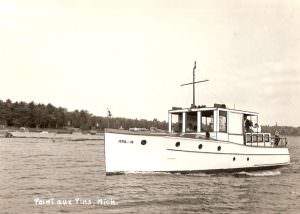 Bois Blanc Island is part of Mackinac County. In 1932, Charles Plaunt initiated a ferry service between the island and Cheboygan. His first ferry, Margaret, transported supplies, U.S. mail, and up to eight passengers per trip. Later, Margaret was replaced by Ada M. (named after Charles’ wife). In later years, Plaunt Transportation used Char-Leann II and then Kristen D.
Bois Blanc Island is part of Mackinac County. In 1932, Charles Plaunt initiated a ferry service between the island and Cheboygan. His first ferry, Margaret, transported supplies, U.S. mail, and up to eight passengers per trip. Later, Margaret was replaced by Ada M. (named after Charles’ wife). In later years, Plaunt Transportation used Char-Leann II and then Kristen D.
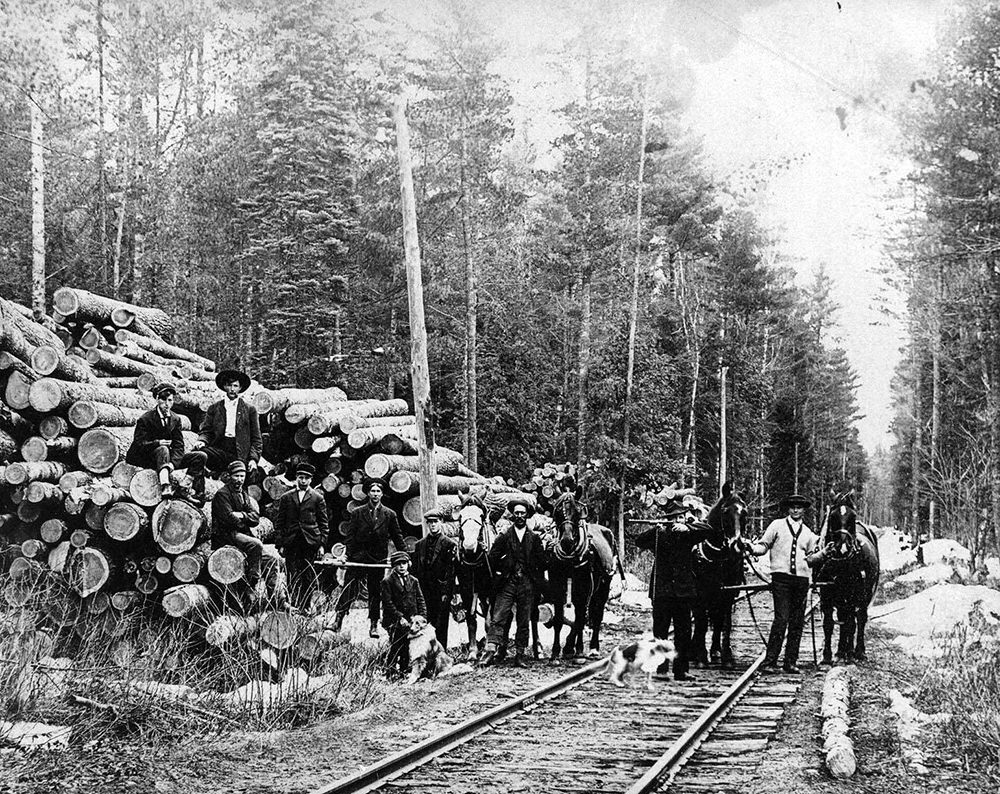 In 1889, J.A. Brawley, formerly employed by the Martel Furnace in St. Ignace, established a lumber camp at Haselmere, Michigan (1 mile west of Engadine). His venture was a success (partly due to the fact that he sold only for cash!!). In its second year, the company cut & shipped 80 railcar loads of telegraph poles & paving poles, along with 10,000 railroad ties. Mr. Brawley’s expectations were for double that amount in his third year.
In 1889, J.A. Brawley, formerly employed by the Martel Furnace in St. Ignace, established a lumber camp at Haselmere, Michigan (1 mile west of Engadine). His venture was a success (partly due to the fact that he sold only for cash!!). In its second year, the company cut & shipped 80 railcar loads of telegraph poles & paving poles, along with 10,000 railroad ties. Mr. Brawley’s expectations were for double that amount in his third year.
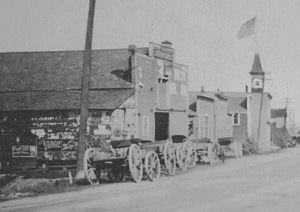 The City Council of the newly-chartered City of St. Ignace was plugging away at setting up the city. At its meeting on April 18, 1883, the following pay scale was put in place: City Clerk and City Attorney were each to be paid $250 per annum, and the City Marshall would be paid $50 per month, plus any fees to which he was entitled by state law. The photo, at right, shows that City Hall is the building with a tower and flag. Looking south from corner of State & Goudreau, the City Hall was located on the water side.
The City Council of the newly-chartered City of St. Ignace was plugging away at setting up the city. At its meeting on April 18, 1883, the following pay scale was put in place: City Clerk and City Attorney were each to be paid $250 per annum, and the City Marshall would be paid $50 per month, plus any fees to which he was entitled by state law. The photo, at right, shows that City Hall is the building with a tower and flag. Looking south from corner of State & Goudreau, the City Hall was located on the water side.
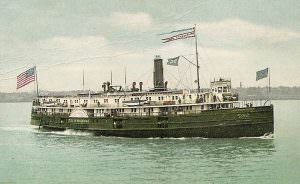 In 1840, the steamboat fare from Mackinac Island to Buffalo, New York was $16 for a cabin and $8 for steerage. Horses could be shipped at $10 apiece.
In 1840, the steamboat fare from Mackinac Island to Buffalo, New York was $16 for a cabin and $8 for steerage. Horses could be shipped at $10 apiece.
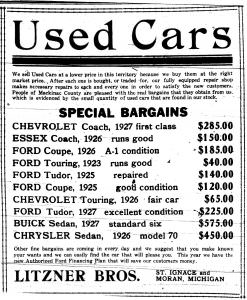 This is a nice time of the year to take a ride in the country. Here are some fine used automobiles offered by a local dealer in May 1929.
This is a nice time of the year to take a ride in the country. Here are some fine used automobiles offered by a local dealer in May 1929.
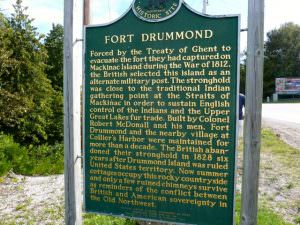 Fort Drummond was the last British fort to be constructed in U.S. territory-1815. Under the Treaty of Ghent, Drummond Island was also awarded to the United States and the British abandoned Fort Drummond in 1828. The U.S. chose not to garrison this fort & it fell into ruin. Fisher Island, located in Whitney Bay, was originally called Target Island, having been used for target practice by the British soldiers. Surgeon Island was so named because the British doctor lived there.
Fort Drummond was the last British fort to be constructed in U.S. territory-1815. Under the Treaty of Ghent, Drummond Island was also awarded to the United States and the British abandoned Fort Drummond in 1828. The U.S. chose not to garrison this fort & it fell into ruin. Fisher Island, located in Whitney Bay, was originally called Target Island, having been used for target practice by the British soldiers. Surgeon Island was so named because the British doctor lived there.
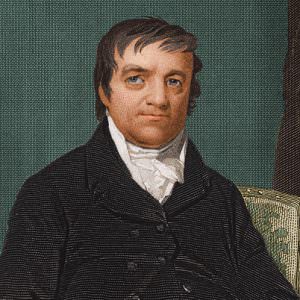 John Jacob Astor’s (1763-1848) extensive fur-trading business, The American Fur Company was headquartered on Mackinac Island, though he never visited there. Because of his lucrative fur business and vast real estate holdings, he became the first millionaire in the United States. At his death in 1848, his estate was valued at 20 million dollars!
John Jacob Astor’s (1763-1848) extensive fur-trading business, The American Fur Company was headquartered on Mackinac Island, though he never visited there. Because of his lucrative fur business and vast real estate holdings, he became the first millionaire in the United States. At his death in 1848, his estate was valued at 20 million dollars!
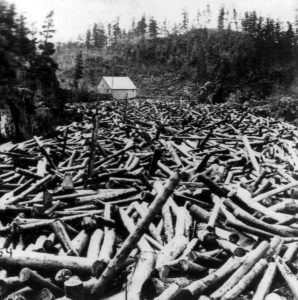 Old-time lumbermen declared the May 1914 Pine River logjam was the largest they had ever seen in an Upper Peninsula stream. It was over two miles long, 10 feet high & had to be broken up by use of a large quantity of dynamite. The jam pushed up over the river’s banks & swept away everything in its path. The big Loomis Lumbercamp & icehouse were driven a quarter of a mile out into the bay. Besides the logs, 20,000 cords of stacked wood were in the jam. This was owned by four different lumber companies. It was estimated that the re-sorting alone would cost $5000.
Old-time lumbermen declared the May 1914 Pine River logjam was the largest they had ever seen in an Upper Peninsula stream. It was over two miles long, 10 feet high & had to be broken up by use of a large quantity of dynamite. The jam pushed up over the river’s banks & swept away everything in its path. The big Loomis Lumbercamp & icehouse were driven a quarter of a mile out into the bay. Besides the logs, 20,000 cords of stacked wood were in the jam. This was owned by four different lumber companies. It was estimated that the re-sorting alone would cost $5000.
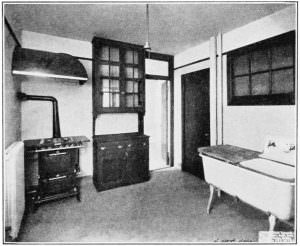 Some August 1930 classified ads for housing included:
Some August 1930 classified ads for housing included:
- 4 room bungalow $8 weekly
- 4 lower rooms & bath. nicely furnished. large yard. enclosed porch. garage. children. $11.50 weekly.
- pleasant 3 room apartment, bath. everything furnished. $6 weekly.
- near post office, 2 room & kitchenette downstairs. running water. private entrance. $8 weekly.
- 6 room flat, includes piano. $80 monthly.
- 3 room, private bath, steam heat, hot water. $40 monthly.
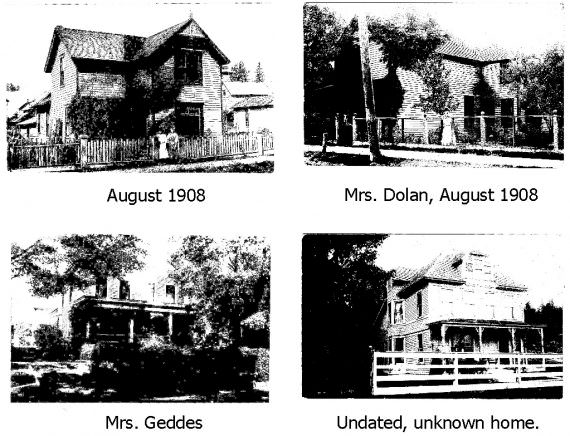 Here are four fine
Here are four fine
St. Ignace homes of yesteryear.
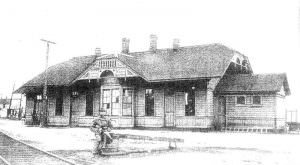
The old DSS&A passenger depot, having been replaced by the depot moved from Moran, was finally sold to Clarence C. Eby. After sitting temporarily across South State Street from its former location, it was moved out onto US-2, west of St. Ignace, in the autumn of 1954. Mr. Eby made it into a souvenir shop after joining it to a shell-covered pagoda-type building and a tall lookout tower. You can still pick out the ornate old depot architecture.
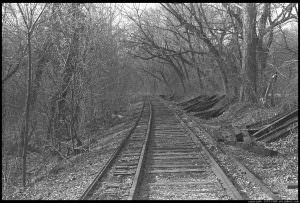 In July 1915, the editor of the St. Ignace Enterprise scolded the State Fire Warden in regard to his warnings to settlers, campers & hunters against the danger of forest fires. On Saturday, July 10 alone, two fires had been started by passing trains “shooting live coals” along the railroad row in the area of Haselmere, Michigan (one mile west of Engadine). Luckily, these fires were noticed by Sandy Brawley & extinguished quickly. There had been seven fires in that area in the previous year. Folks in that part of Mackinac County estimate that 90% of fires in their neck of the woods had been caused by passing trains.
In July 1915, the editor of the St. Ignace Enterprise scolded the State Fire Warden in regard to his warnings to settlers, campers & hunters against the danger of forest fires. On Saturday, July 10 alone, two fires had been started by passing trains “shooting live coals” along the railroad row in the area of Haselmere, Michigan (one mile west of Engadine). Luckily, these fires were noticed by Sandy Brawley & extinguished quickly. There had been seven fires in that area in the previous year. Folks in that part of Mackinac County estimate that 90% of fires in their neck of the woods had been caused by passing trains.
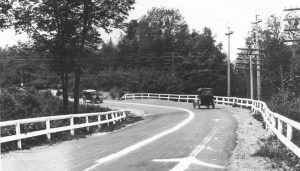 The early 1900s saw many auto-related “firsts”. In 1917, the first highway centerline was painted in the USA. K.I. Sawyer striped M-15 between Marquette and Negaunee.
The early 1900s saw many auto-related “firsts”. In 1917, the first highway centerline was painted in the USA. K.I. Sawyer striped M-15 between Marquette and Negaunee.
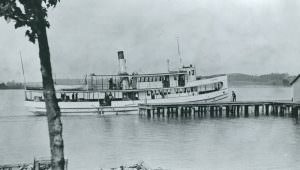 The last gospel ship, 70-foot Glad Tidings, build in 1889, was purchased by James Keightley in 1896 and immediately renamed Elva. Keightley partnered with George Arnold two years later. In 1904, Elva was refitted, adding two new decks and lengthened to 90 feet. Until 1939, she ran among
The last gospel ship, 70-foot Glad Tidings, build in 1889, was purchased by James Keightley in 1896 and immediately renamed Elva. Keightley partnered with George Arnold two years later. In 1904, Elva was refitted, adding two new decks and lengthened to 90 feet. Until 1939, she ran among 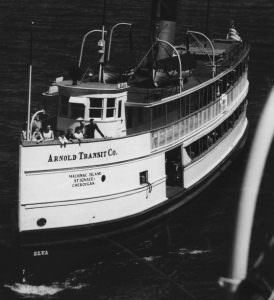 the islands and to ports along the mainland from Cheboygan to Sault Ste. Marie. Converted to a flat-top barge in 1944, she hauled supplies to Mackinac Island until 1953. Arnold Transit planned to burn and scuttle her as part of the Mackinac Bridge groundbreaking ceremonies, but rough weather prohibited this. A few days later, on May 11, 1954, she was burned and sunk a few miles off Mackinac Island’s Arch Rock.
the islands and to ports along the mainland from Cheboygan to Sault Ste. Marie. Converted to a flat-top barge in 1944, she hauled supplies to Mackinac Island until 1953. Arnold Transit planned to burn and scuttle her as part of the Mackinac Bridge groundbreaking ceremonies, but rough weather prohibited this. A few days later, on May 11, 1954, she was burned and sunk a few miles off Mackinac Island’s Arch Rock.
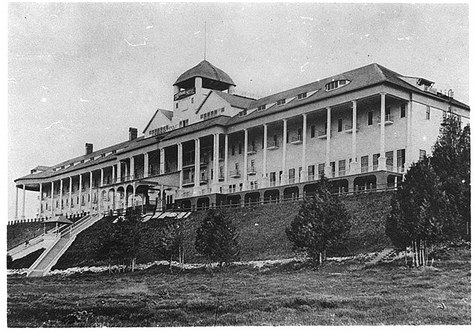 As he presided over a July 1888 Grand Hotel Board of Directors meeting, railroad magnate Cornelius Vanderbilt II declared, “We now have the largest, well-equipped hotel of its kind in the world for a short-season business. Now what we need is a bridge across the Straits.”
As he presided over a July 1888 Grand Hotel Board of Directors meeting, railroad magnate Cornelius Vanderbilt II declared, “We now have the largest, well-equipped hotel of its kind in the world for a short-season business. Now what we need is a bridge across the Straits.”
 In early June 1915, the St. Ignace City Council stated that: as of June 15, any cows or horses found running loose on city streets, would be impounded at the old Central House barn. On Monday, June 15, four cows were impounded. One of these was owned by a city alderman! The four offenders had to pay a fine of one dollar apiece to regain their animals.
In early June 1915, the St. Ignace City Council stated that: as of June 15, any cows or horses found running loose on city streets, would be impounded at the old Central House barn. On Monday, June 15, four cows were impounded. One of these was owned by a city alderman! The four offenders had to pay a fine of one dollar apiece to regain their animals.

In an October 1954, City Council meeting, P.J. Della-Moretta spoke about the Michigan State Highway Department’s plan to by-pass downtown St. Ignace with a four-lane highway north from the Mackinac Bridge. He proposed suggestions for two possible routes which would pass through the downtown:
1. East from the bridge as far as the “Y”, along the shore to State Dock #2 (now the marina area), then “jump” across Moran By to Hazelton Street.
2. Leaving the “Y” to the northwest, traveling behind the downtown along Prospect Street and north to join US-2 (North State Street/Business Loop I-75) in the vicinity of Evergreen Shores.
Mayor John D. Donnelly appointed a committee to seek an audience with the state highway department to discuss these proposed road plans.
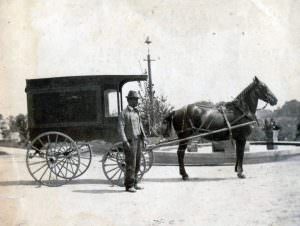 St. Ignace’s first important city ordinance was passed in 1883. It required saloons to close on Sundays. This meant the back door as well as the front! Other early ordinances licensed, regulated and controlled drays and public carriages. These early aldermen had the tremendous task of setting up codes to guide the city’s operations and to provide a means of raising revenue. The first general tax was one percent of the assessed value of personal and private property.
St. Ignace’s first important city ordinance was passed in 1883. It required saloons to close on Sundays. This meant the back door as well as the front! Other early ordinances licensed, regulated and controlled drays and public carriages. These early aldermen had the tremendous task of setting up codes to guide the city’s operations and to provide a means of raising revenue. The first general tax was one percent of the assessed value of personal and private property.
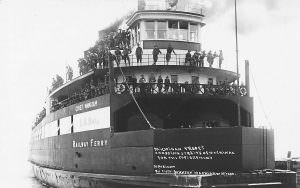 A miners’ strike had come to the Copper Country in the western U.P. The governor had deployed the Michigan National Guard to that area via the railroad. This meant that at least 90 railroad cars full of troops would ride across the Straits of Mackinac aboard railroad ferries Chief Wawatam & Sainte Marie. The strike was honored by 9000 mine workers beginning on Wednesday, July 23, 1913, at the Calumet & Hecla, Quincy, Consolidated, Osceola, Tamarack, Mass, Ahmeek, Kearsarge, Mohawk, Allouez & Wolverine mines. This strike was on account of demands for increased wages, minimum wage scale, shorter hours and to protest the one-man drill.
A miners’ strike had come to the Copper Country in the western U.P. The governor had deployed the Michigan National Guard to that area via the railroad. This meant that at least 90 railroad cars full of troops would ride across the Straits of Mackinac aboard railroad ferries Chief Wawatam & Sainte Marie. The strike was honored by 9000 mine workers beginning on Wednesday, July 23, 1913, at the Calumet & Hecla, Quincy, Consolidated, Osceola, Tamarack, Mass, Ahmeek, Kearsarge, Mohawk, Allouez & Wolverine mines. This strike was on account of demands for increased wages, minimum wage scale, shorter hours and to protest the one-man drill.
In January 1978, the Republican News and St. Ignace enterprise newspaper reported that Mackinac County had received $48,281 from the state for annual snow removal assistance, paying for the previous snow season. Thirty-five (of 83) Michigan counties had qualified for these payments in different amounts, by having received 80 or more inches of snow. A few samples of snowfall – in inches in the Upper Peninsula:
 Mackinac County 136.16
Mackinac County 136.16
Chippewa County 171.00
Luce County 245.00
Keweenaw County 238.00
Alger County 224.00
Ontonagon County 207.00
Houghton County 189.00
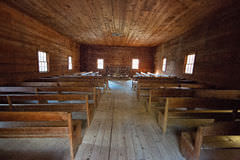 From the beginnings of the white European influence here, the community had predominately worshiped as Catholics. By the 1880’s, the Protestants began to organize their churches. A church known as The First Protestant Church, a 20 by 30 foot structure, was built near the Old Mission Church on State Street. Peter Hombaugh was one participant in its organization. It was razed in 1884, the railroad taking over its site.
From the beginnings of the white European influence here, the community had predominately worshiped as Catholics. By the 1880’s, the Protestants began to organize their churches. A church known as The First Protestant Church, a 20 by 30 foot structure, was built near the Old Mission Church on State Street. Peter Hombaugh was one participant in its organization. It was razed in 1884, the railroad taking over its site.
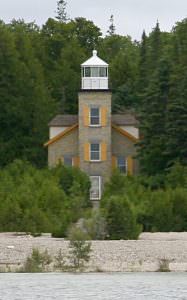 In 1933, Charles Smyth wrote about Bois Blanc Island’s history. The island was heavily lumbered, cutting hardwoods & pine. Stafford Lumber Company had a large sawmill & dock at Sand Bay. Their railroad brought logs from as far as eight miles into the island’s interior. By 1933, the island’s lighthouse was maintained without a keeper – operated by a gas storage system. The U.S. Coast Guard Station was located, then, at Walkers Point. Smyth stated that the population in winter “does not exceed seventy-five”.
In 1933, Charles Smyth wrote about Bois Blanc Island’s history. The island was heavily lumbered, cutting hardwoods & pine. Stafford Lumber Company had a large sawmill & dock at Sand Bay. Their railroad brought logs from as far as eight miles into the island’s interior. By 1933, the island’s lighthouse was maintained without a keeper – operated by a gas storage system. The U.S. Coast Guard Station was located, then, at Walkers Point. Smyth stated that the population in winter “does not exceed seventy-five”.
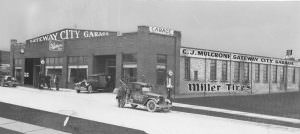 In Eby’s 1925 booklet, Mackinac County of the Straits Country: an Official Guide, was an ad for the Gateway City Garage, C.J. Mulcrone, Proprietor. Offerings: fireproof storage, largest in the county. Repairs on all cars. Dealer for: Packard, Studebaker, Hupmobile & Chevrolet. Telephone 57.
In Eby’s 1925 booklet, Mackinac County of the Straits Country: an Official Guide, was an ad for the Gateway City Garage, C.J. Mulcrone, Proprietor. Offerings: fireproof storage, largest in the county. Repairs on all cars. Dealer for: Packard, Studebaker, Hupmobile & Chevrolet. Telephone 57.
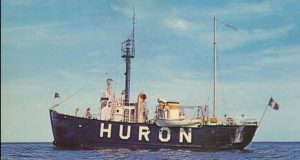 Beginning in 1936, the beacon of Gray’s Reef Lighthouse marked the way, on an artificial island 20 miles west of the Straits of Mackinac in Lake Michigan. Previously, since 1891, four different lightships, in succession, had provided guidance to ships from this reef location. Huron, the last
Beginning in 1936, the beacon of Gray’s Reef Lighthouse marked the way, on an artificial island 20 miles west of the Straits of Mackinac in Lake Michigan. Previously, since 1891, four different lightships, in succession, had provided guidance to ships from this reef location. Huron, the last 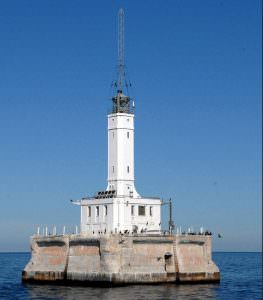 lightship of the Great Lakes (now a museum ship at Port Huron) was one of these. Initially, this lighthouse had a 3 1/2 order Fresnel lens, flashing red, at the top of the 115-step tower. In 1965, this lighthouse was struck by a passing ship one foggy night. The lighthouse suffered only minor damage. The ship’s bow was battered, but she was able to keep on her way. In 1976, the Fresnel lens was replaced and the lighthouse was automated.
lightship of the Great Lakes (now a museum ship at Port Huron) was one of these. Initially, this lighthouse had a 3 1/2 order Fresnel lens, flashing red, at the top of the 115-step tower. In 1965, this lighthouse was struck by a passing ship one foggy night. The lighthouse suffered only minor damage. The ship’s bow was battered, but she was able to keep on her way. In 1976, the Fresnel lens was replaced and the lighthouse was automated.
Dotting the ice of Moran Bay, shanties made the popular sport of ice fishing more comfortable. We don’t see them out on the Big Lake so much anymore.
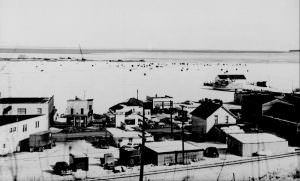
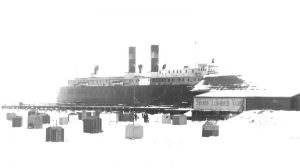
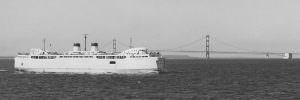 Over the course of the 34-year (1923-1957) lifespan of the Michigan State Car Ferry System, there were eight ferries: Ariel, Sainte Ignace, Mackinaw City, The Straits of Mackinac, City of Cheboygan, City of Munising, City of Petoskey, and Vacationland. The Vacationland is in the photo above, taken on Halloween Day 1957, on the eve of the opening of the Mackinac Bridge.
Over the course of the 34-year (1923-1957) lifespan of the Michigan State Car Ferry System, there were eight ferries: Ariel, Sainte Ignace, Mackinaw City, The Straits of Mackinac, City of Cheboygan, City of Munising, City of Petoskey, and Vacationland. The Vacationland is in the photo above, taken on Halloween Day 1957, on the eve of the opening of the Mackinac Bridge.
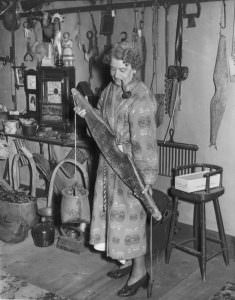 Genevieve (Derusha) Goudreau (1865-1958) and her husband, Captain Louis Goudreau came to St. Ignace in 1886. Known as “Aunt Jane” by all her friends, she had been born at Seul Choix and lived on Beaver Island and at Epoufette. At age 15, she washed dishes at a lumber camp for 50 cents a week. In this photo, taken in 1948, she shows a sap bucket and neck yoke she used as a child. In interviews, Aunt Jane told many stories of life in the small villages along Lake Michigan’s shore. She said she had begun smoking a pipe on her 15th birthday..
Genevieve (Derusha) Goudreau (1865-1958) and her husband, Captain Louis Goudreau came to St. Ignace in 1886. Known as “Aunt Jane” by all her friends, she had been born at Seul Choix and lived on Beaver Island and at Epoufette. At age 15, she washed dishes at a lumber camp for 50 cents a week. In this photo, taken in 1948, she shows a sap bucket and neck yoke she used as a child. In interviews, Aunt Jane told many stories of life in the small villages along Lake Michigan’s shore. She said she had begun smoking a pipe on her 15th birthday..
 By 1892, the City of St. Ignace had constructed the municipal electric power plant and was installing street lights. They chose to place these lights on State Street at: Paro, Hamlin, Burdette, Spruce, Keightley, High, Spring, Truckey, at Chambers Dock, Goudreau Alley (now Central Hill), Moloney (now Goudreau), Marquette, Preston (apparently Balsam now), Stockbridge, Hazelton and Antoine. Lights were also placed at Mary and Goudreau, Portage and Marley, Portage and Prospect and at Church and McCann.
By 1892, the City of St. Ignace had constructed the municipal electric power plant and was installing street lights. They chose to place these lights on State Street at: Paro, Hamlin, Burdette, Spruce, Keightley, High, Spring, Truckey, at Chambers Dock, Goudreau Alley (now Central Hill), Moloney (now Goudreau), Marquette, Preston (apparently Balsam now), Stockbridge, Hazelton and Antoine. Lights were also placed at Mary and Goudreau, Portage and Marley, Portage and Prospect and at Church and McCann.
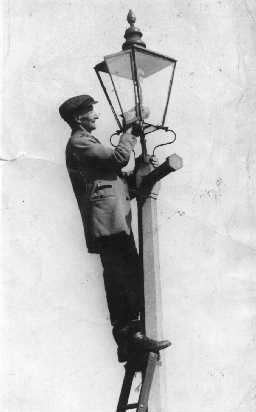 St. Ignace’s first street lights were kerosene lamps. In 1887, Daniel Kenter (a Civil War veteran who had a dray and baggage-handling business) was engaged to care for these lamps. For a time, D.O. Vigeant was the lamplighter. With the installation of the electric power plant in 1892, came carbon streetlights. The cost of this electric power plant was $7000.00. The first engineer to manage the water and electric power plant was Richard Boulton. He was appointed in 1892 and paid $75.00 per month. For these wages, he was responsible for all electrical work required by the city.
St. Ignace’s first street lights were kerosene lamps. In 1887, Daniel Kenter (a Civil War veteran who had a dray and baggage-handling business) was engaged to care for these lamps. For a time, D.O. Vigeant was the lamplighter. With the installation of the electric power plant in 1892, came carbon streetlights. The cost of this electric power plant was $7000.00. The first engineer to manage the water and electric power plant was Richard Boulton. He was appointed in 1892 and paid $75.00 per month. For these wages, he was responsible for all electrical work required by the city.
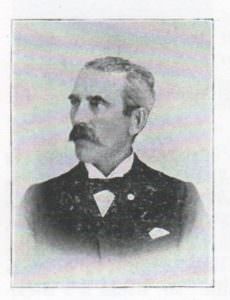 Alfred J. Gennell was born on Mackinac Island in 1844. He served in the Civil War, then went into wholesale fish business in Chicago for 18 years. He settled in St. Ignace in 1882, going into the grocery and bakery business. Mr. Gennell was the Mackinac County Register of Deeds for nine years and served as St. Ignace City Clerk for 18 years. He was also active in the real estate business. He and his family lived on Joseph Street. He was the last surviving local Civil War veteran, passing in 1935 at the age of 92 years.
Alfred J. Gennell was born on Mackinac Island in 1844. He served in the Civil War, then went into wholesale fish business in Chicago for 18 years. He settled in St. Ignace in 1882, going into the grocery and bakery business. Mr. Gennell was the Mackinac County Register of Deeds for nine years and served as St. Ignace City Clerk for 18 years. He was also active in the real estate business. He and his family lived on Joseph Street. He was the last surviving local Civil War veteran, passing in 1935 at the age of 92 years.
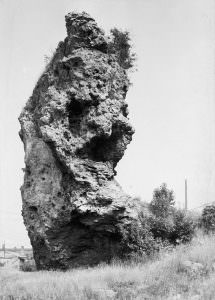 The Board of Aldermen was seeking to obtain the land and construct a park around St. Anthony’s Rock in August 1891. A piece of land 80×200 feet, owned by the Conrad brothers and City Marshall Joseph Goudreau, was made available at very low cost. Chambers Brothers owned a small triangle-shaped piece at the rear, which would be donated. The aldermen envisioned the park with a fence, benches, a fountain and trees planted, to be in place by the Spring of 1892.
The Board of Aldermen was seeking to obtain the land and construct a park around St. Anthony’s Rock in August 1891. A piece of land 80×200 feet, owned by the Conrad brothers and City Marshall Joseph Goudreau, was made available at very low cost. Chambers Brothers owned a small triangle-shaped piece at the rear, which would be donated. The aldermen envisioned the park with a fence, benches, a fountain and trees planted, to be in place by the Spring of 1892.
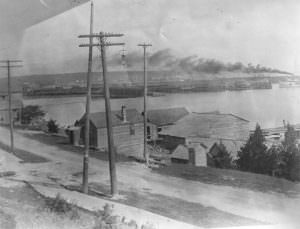 Peter W. Hombach, St. Ignace’s first postmaster (1874-1887), arrived here from Germany via Mackinac Island, where he had worked as a cooper. He also served on the Board of Public Works & as city assessor. That first post office was located on the south part of State Street, near his dock. He also kept store near Spruce & State Street. Mr. Hombach sold feed for the lumber camps’ horses & was later awarded the land in Private Claim #3. He died at his winter home in Peru, Indiana on December 23, 1915 at age 80, and was buried at St. Ignace’s Lakeside Cemetery. Mr. Hombach was know for his honesty and integrity, was a stickler for business ethics and once his word was given, it was never broken.
Peter W. Hombach, St. Ignace’s first postmaster (1874-1887), arrived here from Germany via Mackinac Island, where he had worked as a cooper. He also served on the Board of Public Works & as city assessor. That first post office was located on the south part of State Street, near his dock. He also kept store near Spruce & State Street. Mr. Hombach sold feed for the lumber camps’ horses & was later awarded the land in Private Claim #3. He died at his winter home in Peru, Indiana on December 23, 1915 at age 80, and was buried at St. Ignace’s Lakeside Cemetery. Mr. Hombach was know for his honesty and integrity, was a stickler for business ethics and once his word was given, it was never broken.
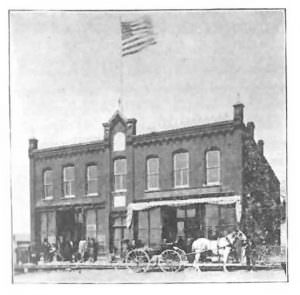
A native of Germany, Frederick Kruger (1853-1925) was employed as an engineer and machinist in the Mackinaw Lumber Company’s mill here at first. In 1890, he built the Kruger Block, an elegant two-story brick building at what is now the corner of State and State A Streets (currently the Mackinac County Road Commission office site). He first went into the saloon business there, but soon transited into heavy groceries: flour, barrel beef and pork, smoked and salted meats. He offered a line of canned goods, and provisions at wholesale and retail. Kruger also operated a fleet of fishing boats. He was the village assessor for the one year before St. Ignace became a city. Mr. Kruger served as postmaster from 1897 to 1914, serving under four presidential administrations – McKinley, Roosevelt, Taft and Wilson. Later he served as courthouse janitor and jailor. He was also appointed as a member of the county poor commission by the Mackinac Board of Supervisors.
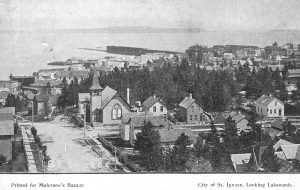 Clarence Eby, a local businessman, sought to inform and encourage the public to visit our area. He published guidebooks for prospective tourists, telling them what they’d encounter, which included a nice little step-by-step mileage guide. In the 1925 edition, he stated: “It is rumored that many misleading reports have been given out at various places in regard to accommodations, road conditions and prevailing prices to be found in and about the Straits Country. It is suggested that the reader take into consideration that in all communities where competition is keenly felt, a certain element will generally be found consisting of persons whose interest in the visitor is measured by the latter’s spending capacity. For the benefit of the stranger it is advised that he ignore all the “inside stuff” being peddled by the confidential whisperer who knows absolutely no accommodations other than those in which he is directly interested. A few moments spent on these pages will leave it necessary to ask but few questions.”
Clarence Eby, a local businessman, sought to inform and encourage the public to visit our area. He published guidebooks for prospective tourists, telling them what they’d encounter, which included a nice little step-by-step mileage guide. In the 1925 edition, he stated: “It is rumored that many misleading reports have been given out at various places in regard to accommodations, road conditions and prevailing prices to be found in and about the Straits Country. It is suggested that the reader take into consideration that in all communities where competition is keenly felt, a certain element will generally be found consisting of persons whose interest in the visitor is measured by the latter’s spending capacity. For the benefit of the stranger it is advised that he ignore all the “inside stuff” being peddled by the confidential whisperer who knows absolutely no accommodations other than those in which he is directly interested. A few moments spent on these pages will leave it necessary to ask but few questions.”
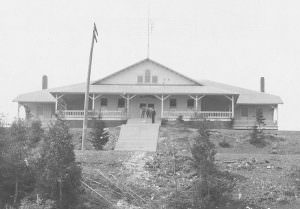 The 1914 Independence Day celebration in St. Ignace was highlighted by an automobile race. The autoists (as they were then called) raced from the foot of Maloney Hill (now Goudreau Street) to the Pavilion (on south State Street, just south of current Hombach Street). The winner of the silver loving cup and $10 in cash was John B. Vallier in his runabout. Tied for second place were E.J. Chatelle and Bert Ellsworth, both driving Fords. It was not a race without incident, however. Nearing the end, Milton Taylor, trying to pass another automobile, ran into a telephone pole. His machine was smashed; he and another man were injured-not seriously. The Pavilion is pictured above right.
The 1914 Independence Day celebration in St. Ignace was highlighted by an automobile race. The autoists (as they were then called) raced from the foot of Maloney Hill (now Goudreau Street) to the Pavilion (on south State Street, just south of current Hombach Street). The winner of the silver loving cup and $10 in cash was John B. Vallier in his runabout. Tied for second place were E.J. Chatelle and Bert Ellsworth, both driving Fords. It was not a race without incident, however. Nearing the end, Milton Taylor, trying to pass another automobile, ran into a telephone pole. His machine was smashed; he and another man were injured-not seriously. The Pavilion is pictured above right.
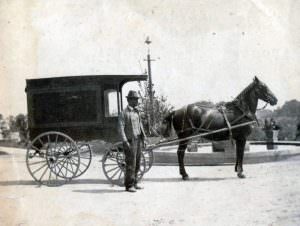 In 1883, the City of St. Ignace licensed commercial horse-drawn vehicles of all sorts. Dray vehicles using one animal, whether 2- or 4- wheeled, paid $3 yearly for a permit; any drawn by four animals were $4 yearly. The rates draymen could charge were also regulated: drays pulled by two or more animals & traveling less than one mile = 40 cents per load; 25 cents for each additional mile. Those pulled by one animal, under one mile = 25 cents per load, 15 cents for each additional mile. The assigned license number must be posted on both sides of the vehicle, in figures “at least 1 1/2 inches long”. Draymen were entitled to immediate payment-or they could retain the hauled items until the mayor settled the dispute. The mayor’s settlement was binding upon the two parties. Draymen were not allowed to leave their rigs unattended. Additionally, they may not flourish their whip or “use rude or boisterous talk as to disturb people along the street.”
In 1883, the City of St. Ignace licensed commercial horse-drawn vehicles of all sorts. Dray vehicles using one animal, whether 2- or 4- wheeled, paid $3 yearly for a permit; any drawn by four animals were $4 yearly. The rates draymen could charge were also regulated: drays pulled by two or more animals & traveling less than one mile = 40 cents per load; 25 cents for each additional mile. Those pulled by one animal, under one mile = 25 cents per load, 15 cents for each additional mile. The assigned license number must be posted on both sides of the vehicle, in figures “at least 1 1/2 inches long”. Draymen were entitled to immediate payment-or they could retain the hauled items until the mayor settled the dispute. The mayor’s settlement was binding upon the two parties. Draymen were not allowed to leave their rigs unattended. Additionally, they may not flourish their whip or “use rude or boisterous talk as to disturb people along the street.”
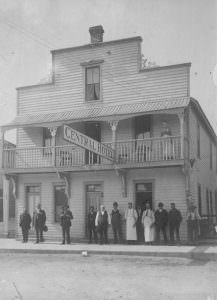
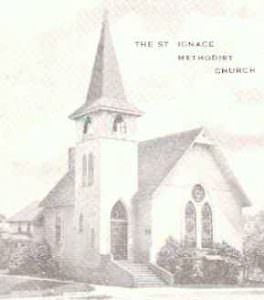 On Sunday, April 12, 1914, vandals attacked at several sites in
On Sunday, April 12, 1914, vandals attacked at several sites in
St. Ignace. Two large stained glass windows and two basement windows in the Methodist Church were smashed by stones. Two windows at Snyder’s Central Hotel were broken shortly before the church windows. The St. Ignace Enterprise reported that surely this was done by the same person, in “an act of depravity”.
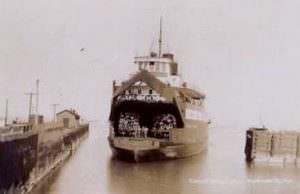 Before the Michigan State Car Ferry System was built in 1923, automobiles were transported across the Straits of Mackinac, now & then, via railroad ferries. In August 1919, the railroad administration “at Washington” reduced auto fares to a flat rate of $4 per car with a $1 dockage charged at each end of the trip. Previously, motorists paid by the old “per hundred-weight” scale. Under the old system, baggage carried in an auto was ferried at 20 cents per hundred pounds, meaning that the average vehicle seldom crossed for under $10. The old rate of 50 cents per passenger remained in effect.
Before the Michigan State Car Ferry System was built in 1923, automobiles were transported across the Straits of Mackinac, now & then, via railroad ferries. In August 1919, the railroad administration “at Washington” reduced auto fares to a flat rate of $4 per car with a $1 dockage charged at each end of the trip. Previously, motorists paid by the old “per hundred-weight” scale. Under the old system, baggage carried in an auto was ferried at 20 cents per hundred pounds, meaning that the average vehicle seldom crossed for under $10. The old rate of 50 cents per passenger remained in effect.
 Robert Harris had the first large dairy farm in the St. Ignace area, out on Portage Road. This farm was later taken over by Charles Hildebrandt. He sold from a wagon or sleigh. Milk was 5 cents per quart, drawn from five gallon cans with spouts. This milk came directly from his dairy cows, ho pasteurizing or other processing. The following morning, it would yield cream on top. Others who sold milk in this period were: Andrew Axelson, Del Avery, Ed Lawson, Julius Benson and Pat Gallagher.
Robert Harris had the first large dairy farm in the St. Ignace area, out on Portage Road. This farm was later taken over by Charles Hildebrandt. He sold from a wagon or sleigh. Milk was 5 cents per quart, drawn from five gallon cans with spouts. This milk came directly from his dairy cows, ho pasteurizing or other processing. The following morning, it would yield cream on top. Others who sold milk in this period were: Andrew Axelson, Del Avery, Ed Lawson, Julius Benson and Pat Gallagher.
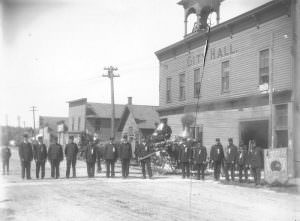 The fire department was organized in St. Ignace on July 1, 1883. The first fire chief was Simeon A. Snyder, a local hotelier and businessman who was also a Civil War veteran. The volunteer firemen, at first, drew simple hose carts to fires. Later, horse-drawn steamers were used for pumping water until the city developed its water system.
The fire department was organized in St. Ignace on July 1, 1883. The first fire chief was Simeon A. Snyder, a local hotelier and businessman who was also a Civil War veteran. The volunteer firemen, at first, drew simple hose carts to fires. Later, horse-drawn steamers were used for pumping water until the city developed its water system.
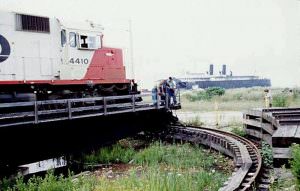 Over time, St. Ignace was the site of several different railroad turntables. The function of a turntable is to turn a locomotive around, so that it can travel back in the direction from which it came. Though locomotives can run in reverse, their controls were often not configured for extended periods of running backward and in many, the top reverse speed was slower. For the turntable pictured here, the locomotive’s own air cylinder was used to push the turntable.
Over time, St. Ignace was the site of several different railroad turntables. The function of a turntable is to turn a locomotive around, so that it can travel back in the direction from which it came. Though locomotives can run in reverse, their controls were often not configured for extended periods of running backward and in many, the top reverse speed was slower. For the turntable pictured here, the locomotive’s own air cylinder was used to push the turntable.
 February 1 was the second day of the 1934 ice harvest season for George A. Litchard & his son, Loren. They projected the total harvest to take two weeks. Excellent 16-inch thick pure blue crystal ice was being taken out of Moran Bay. Trucks were used to transport the ice blocks to Litchard’s two icehouses, which would take 1200 cords of ice to fill. Modern machinery was used to clear the ice field of poor top ice & snow, cut the blocks and lift them out of the water. The Litchards had been ice dealers for many years.
February 1 was the second day of the 1934 ice harvest season for George A. Litchard & his son, Loren. They projected the total harvest to take two weeks. Excellent 16-inch thick pure blue crystal ice was being taken out of Moran Bay. Trucks were used to transport the ice blocks to Litchard’s two icehouses, which would take 1200 cords of ice to fill. Modern machinery was used to clear the ice field of poor top ice & snow, cut the blocks and lift them out of the water. The Litchards had been ice dealers for many years.
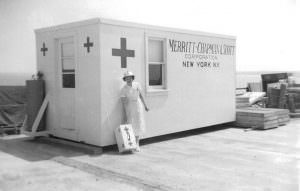 Three nurses; Isabelle Hagen, Helen Kalmer and Phyllis Tuck, were the only women except official inspection parties, allowed on the Mackinac Bridge during construction. In 1954, Hagen courageously entered a decompression chamber for 24 hours in an attempt to save lead diver, Frank Pepper, from the bends. Mr. Pepper was the first of five bridge construction fatalities.
Three nurses; Isabelle Hagen, Helen Kalmer and Phyllis Tuck, were the only women except official inspection parties, allowed on the Mackinac Bridge during construction. In 1954, Hagen courageously entered a decompression chamber for 24 hours in an attempt to save lead diver, Frank Pepper, from the bends. Mr. Pepper was the first of five bridge construction fatalities.
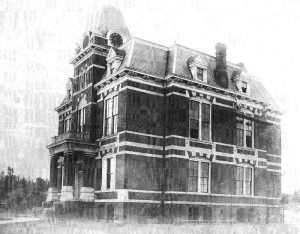 Michilimackinac County was set off as a judicial district in 1818. By 1820, court was being convened at the courthouse on Mackinac Island, which was the county seat. By 1882, St. Ignace had been voted in as county seat and a new courthouse was built here (as now, at the corner of Marley and Portage Streets). In those early years, federal judges came here from Washington, DC to hold court once each year. They traveled by boat, on foot and on horseback to get here; the trip requiring up to six weeks.
Michilimackinac County was set off as a judicial district in 1818. By 1820, court was being convened at the courthouse on Mackinac Island, which was the county seat. By 1882, St. Ignace had been voted in as county seat and a new courthouse was built here (as now, at the corner of Marley and Portage Streets). In those early years, federal judges came here from Washington, DC to hold court once each year. They traveled by boat, on foot and on horseback to get here; the trip requiring up to six weeks.
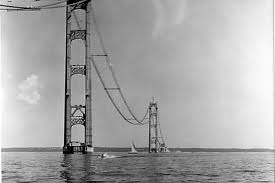 “I confess I was awed by my first view of the vast expanse of water to be bridged. One shore was hardly visible from the other. My awe turned into a silent prayer.”
“I confess I was awed by my first view of the vast expanse of water to be bridged. One shore was hardly visible from the other. My awe turned into a silent prayer.”
—David B. Steinman, Mackinac Bridge design engineer (1950)
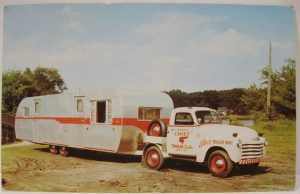 With construction of the Mackinac Bridge imminent, many folks knew that there would be a housing shortage in the St. Ignace area. One quick solution was to make house trailers available. Just a few of the “landlords” who applied for licensing from the city in early 1954 were: R. Cheeseman-for 20 trailers at 404 Portage (by April 1954, there were 16 in place), Patrick Gallagher-for 7 on Church Street, Allen Lester-for 3 at 159 First Street. Still others made space available in houses and other buildings. The storey above Bentley’s Restaurant was converted into a bunkhouse.
With construction of the Mackinac Bridge imminent, many folks knew that there would be a housing shortage in the St. Ignace area. One quick solution was to make house trailers available. Just a few of the “landlords” who applied for licensing from the city in early 1954 were: R. Cheeseman-for 20 trailers at 404 Portage (by April 1954, there were 16 in place), Patrick Gallagher-for 7 on Church Street, Allen Lester-for 3 at 159 First Street. Still others made space available in houses and other buildings. The storey above Bentley’s Restaurant was converted into a bunkhouse.
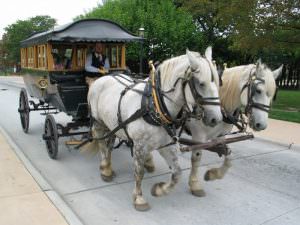 By 1888, the City of St. Ignace experimented with a street car, of sorts. At least two of these coaches were built, by Edmison & Son, blacksmiths and wagon-makers. These horse-drawn carriages ran on wooden tracks to keep them from becoming mired in the ruts. Capable of accommodating up to 24 passengers, they ran from the Martel Furnace (now site of the U.S. Coast Guard) to the Mackinaw Lumber Company (now the Shepler’s Ferry area). This plan turned out to be impractical.
By 1888, the City of St. Ignace experimented with a street car, of sorts. At least two of these coaches were built, by Edmison & Son, blacksmiths and wagon-makers. These horse-drawn carriages ran on wooden tracks to keep them from becoming mired in the ruts. Capable of accommodating up to 24 passengers, they ran from the Martel Furnace (now site of the U.S. Coast Guard) to the Mackinaw Lumber Company (now the Shepler’s Ferry area). This plan turned out to be impractical.
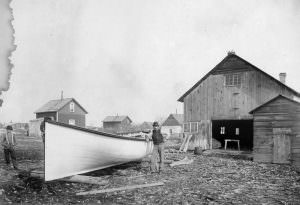 Local boat builders, the Chenier brothers, were commissioned to build a Mackinaw Boat and awarded a contract by Government Light House Inspector Reid. This boat would be assigned to Lighthouse keeper William Marshall at Spectacle Reef Lighthouse. She was completed in less than one month and delivered to Fort Mackinac in mid-May 1893. She was a 28-footer with an 8-foot beam, fully rigged; her mainsail being 17 feet high. This boat – of fine workmanship – cost $260.00
Local boat builders, the Chenier brothers, were commissioned to build a Mackinaw Boat and awarded a contract by Government Light House Inspector Reid. This boat would be assigned to Lighthouse keeper William Marshall at Spectacle Reef Lighthouse. She was completed in less than one month and delivered to Fort Mackinac in mid-May 1893. She was a 28-footer with an 8-foot beam, fully rigged; her mainsail being 17 feet high. This boat – of fine workmanship – cost $260.00
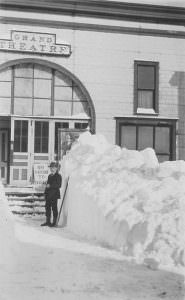 Ticket prices of 10 & 15 cents were charged at St. Ignace’s Grand Theatre for a special presentation on Wednesday, May 6, 1914. It was a 2-reel film of an actual battle between Gen. Pancho Villa’s revolutionist forces and Huerta’s federalist troops in Mexico. Although the United States military was not involved, Villa allowed Mutual Movies camera crews to accompany his army in the Battle of Ojnaga.
Ticket prices of 10 & 15 cents were charged at St. Ignace’s Grand Theatre for a special presentation on Wednesday, May 6, 1914. It was a 2-reel film of an actual battle between Gen. Pancho Villa’s revolutionist forces and Huerta’s federalist troops in Mexico. Although the United States military was not involved, Villa allowed Mutual Movies camera crews to accompany his army in the Battle of Ojnaga.
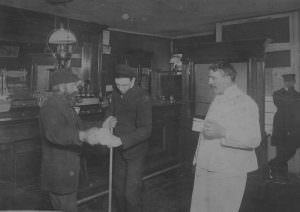 In 1915, there were ten licensed saloons in St. Ignace. In late April, City Council re-approved them after they presented their bonds. These establishments were owned by: Joseph Smith, John B. Vallier, Chris Sorenson, D. Lenahan & Son, Simeon Snyder, William McEver, A. Mosher, M. McGrath, Whitwell Brothers, and Frank Vallier.
In 1915, there were ten licensed saloons in St. Ignace. In late April, City Council re-approved them after they presented their bonds. These establishments were owned by: Joseph Smith, John B. Vallier, Chris Sorenson, D. Lenahan & Son, Simeon Snyder, William McEver, A. Mosher, M. McGrath, Whitwell Brothers, and Frank Vallier.
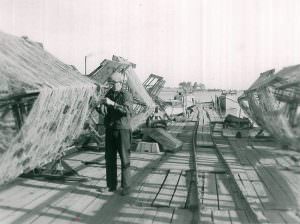 Peter Paquin was a fisherman who lived at Prentiss Bay near Cedarville for 38 years. His parents, Antoine and Susan LaVake Paquin both hailed from Canada and Peter was born in St. Ignace on September 16, 1859. Antoine helped build the Old Mission Catholic Church in the late 1830s. Peter was elected as the first treasurer of the Village of St. Ignace and later served as the city sheriff from 1883-1886. He died September 14, 1935 at age 75.
Peter Paquin was a fisherman who lived at Prentiss Bay near Cedarville for 38 years. His parents, Antoine and Susan LaVake Paquin both hailed from Canada and Peter was born in St. Ignace on September 16, 1859. Antoine helped build the Old Mission Catholic Church in the late 1830s. Peter was elected as the first treasurer of the Village of St. Ignace and later served as the city sheriff from 1883-1886. He died September 14, 1935 at age 75.
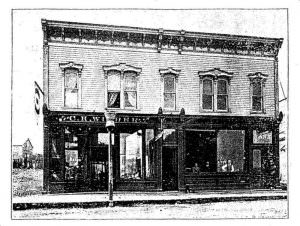 First National Bank was organized in 1888 with $50,000.00 in capital stock. Shown here in its first site, First National Bank occupied the right portion of the building that it shared with Wilber Drugs. This building was known as the Bank Block. It was located on State Street, just north of the current bank.
First National Bank was organized in 1888 with $50,000.00 in capital stock. Shown here in its first site, First National Bank occupied the right portion of the building that it shared with Wilber Drugs. This building was known as the Bank Block. It was located on State Street, just north of the current bank.
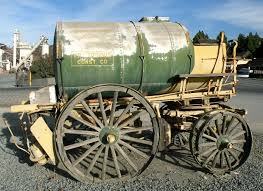 Walking in downtown St. Ignace was most often dusty or muddy, by turns. Starting in 1883, wooden sidewalks helped with the mud. The City’s water wagon helped by sprinkling the streets to keep the dust down. Eventually, some of the wooden sidewalks were replaced with cement. In 1925, State Street was paved. At that time the power and telephone poles were moved back behind the stores and into the alley which ran through along the railroad’s right-of-way.
Walking in downtown St. Ignace was most often dusty or muddy, by turns. Starting in 1883, wooden sidewalks helped with the mud. The City’s water wagon helped by sprinkling the streets to keep the dust down. Eventually, some of the wooden sidewalks were replaced with cement. In 1925, State Street was paved. At that time the power and telephone poles were moved back behind the stores and into the alley which ran through along the railroad’s right-of-way.
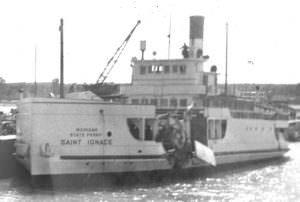 Thick fog caused a collision of two Michigan State Car Ferries on June 8, 1939. Northbound City of Cheboygan smashed broadside into southbound Saint Ignace. A 20-foot hole ripped in her side, above the water line crippled Saint Ignace. Collapsed upper deck beams smashed down onto occupied cars below, injuring eight people. The ship’s cook was scalded by hot soup. Passengers were ordered into life vests. Saint Ignace was sent off to Lund’s shipyard for $10,000 of repairs. City of Cheboygan sustained minor damage and no personal injuries. Her bow was repainted and she was back in service that same afternoon.
Thick fog caused a collision of two Michigan State Car Ferries on June 8, 1939. Northbound City of Cheboygan smashed broadside into southbound Saint Ignace. A 20-foot hole ripped in her side, above the water line crippled Saint Ignace. Collapsed upper deck beams smashed down onto occupied cars below, injuring eight people. The ship’s cook was scalded by hot soup. Passengers were ordered into life vests. Saint Ignace was sent off to Lund’s shipyard for $10,000 of repairs. City of Cheboygan sustained minor damage and no personal injuries. Her bow was repainted and she was back in service that same afternoon.
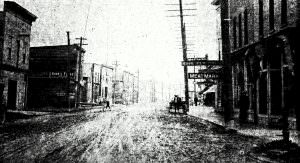 After St. Ignace gained its status as a city in 1883, the new city council (aldermen) tackled the tremendous job of building and improving the streets. One or two buildings had to be moved from the center of State Street, where horses and wagons had been detouring around them for years. In trying to develop a 66-foot wide right-of-way, several other buildings which had been built at irregular angles had to be relocated.
After St. Ignace gained its status as a city in 1883, the new city council (aldermen) tackled the tremendous job of building and improving the streets. One or two buildings had to be moved from the center of State Street, where horses and wagons had been detouring around them for years. In trying to develop a 66-foot wide right-of-way, several other buildings which had been built at irregular angles had to be relocated.
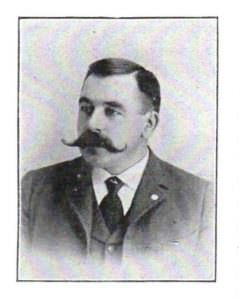 John Fritschen was born in Germany, coming to the United States and immediately to Michigan’s Upper Peninsula in 1881. Two years later he came to St. Ignace, earning his living at jobbing, contracting, etc. By 1888, he was in business for himself, as a saloon keeper. Two years later, he moved his business across State Street into the Cubley Block, offering wines, liquors, cigars, lagers and export beers. Besides the bar, he provided comfortable furnished sitting rooms in the rear. He was the city’s night watchman (patrolling mainly to watch for fires), City Marshall, First Ward Aldermen, First Ward Supervisor, member of County Board of Supervisors, and he was the U.S. Marshall in our area.
John Fritschen was born in Germany, coming to the United States and immediately to Michigan’s Upper Peninsula in 1881. Two years later he came to St. Ignace, earning his living at jobbing, contracting, etc. By 1888, he was in business for himself, as a saloon keeper. Two years later, he moved his business across State Street into the Cubley Block, offering wines, liquors, cigars, lagers and export beers. Besides the bar, he provided comfortable furnished sitting rooms in the rear. He was the city’s night watchman (patrolling mainly to watch for fires), City Marshall, First Ward Aldermen, First Ward Supervisor, member of County Board of Supervisors, and he was the U.S. Marshall in our area.
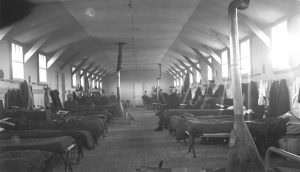 In 1935, CCC Camp Round lake was founded in Marquette National Forest (now Hiawatha National Forest), by enrollees moving from Camp Kenneth. From 1935 to 1937, these young men constructed Brevort Lake Campground: log shelters, bath houses, toilets, wells, tables, bulletin boards, fireplaces and a gravel road from US-2. In 1937, they built the Brevort Lake Dam, which controls the lake’s water level. They developed the Lake Michigan Campground in 1939-1940. Other projects they completed were the planting of 15,000-20,000 acres of pine seedlings. Other duties included fire-fighting and the improvement of roads, bridges and fish habitat. This camp, located on Mackinac County Road H-57 (now Brevort Lake Road), was closed in 1942.
In 1935, CCC Camp Round lake was founded in Marquette National Forest (now Hiawatha National Forest), by enrollees moving from Camp Kenneth. From 1935 to 1937, these young men constructed Brevort Lake Campground: log shelters, bath houses, toilets, wells, tables, bulletin boards, fireplaces and a gravel road from US-2. In 1937, they built the Brevort Lake Dam, which controls the lake’s water level. They developed the Lake Michigan Campground in 1939-1940. Other projects they completed were the planting of 15,000-20,000 acres of pine seedlings. Other duties included fire-fighting and the improvement of roads, bridges and fish habitat. This camp, located on Mackinac County Road H-57 (now Brevort Lake Road), was closed in 1942.
 In 1878 or 79, a group of young church choir singers from Toronto stopped at St. Ignace on an excursion aboard the steamer Atlantic. When they found that they’d be in port until 10 or 11 pm, they proposed inviting the townspeople to a concert aboard their steamship. The invitation was extended and Atlantic’s saloon was crowded. Among the guests were Judge C.R. Brown and his family, accompanied by their dog. At some point, the little dog set up a howl and he was exiled to the afterdeck. Long after they sailed, someone found the dog, but St. Ignace was far behind. A young man, Egbert Clark, took care of the dog until a sister steamer Pacific, passed close to Atlantic. Clark had the dog transferred with a letter requesting care for his charge and that the dog be let off at St. Ignace. Mr. Clark received a letter from Judge Brown thanking him for when “our doggie came running and jumping into our home, to the great joy of our little ones.”
In 1878 or 79, a group of young church choir singers from Toronto stopped at St. Ignace on an excursion aboard the steamer Atlantic. When they found that they’d be in port until 10 or 11 pm, they proposed inviting the townspeople to a concert aboard their steamship. The invitation was extended and Atlantic’s saloon was crowded. Among the guests were Judge C.R. Brown and his family, accompanied by their dog. At some point, the little dog set up a howl and he was exiled to the afterdeck. Long after they sailed, someone found the dog, but St. Ignace was far behind. A young man, Egbert Clark, took care of the dog until a sister steamer Pacific, passed close to Atlantic. Clark had the dog transferred with a letter requesting care for his charge and that the dog be let off at St. Ignace. Mr. Clark received a letter from Judge Brown thanking him for when “our doggie came running and jumping into our home, to the great joy of our little ones.”
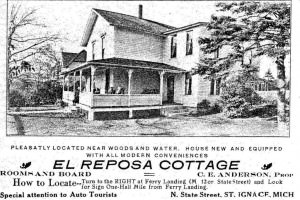 Vacationers were welcomed by C.E. Anderson in 1925. Note that “auto tourists” were given special attention!
Vacationers were welcomed by C.E. Anderson in 1925. Note that “auto tourists” were given special attention!
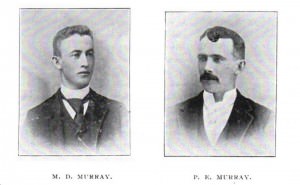 Michael D. and Patrick E. Murray formed their partnership as wholesale and retail grocery and provisions dealers. They eventually had two outlets. The heavier trades: flour, grain, feed, oats and hay were sold from a store on State Street at the corner of Goudreau Alley (now Central Hill). The lighter items: fruits, vegetables, crockery, glassware and lumbermen’s items could be purchased at their store on the corner of State and Truckey Streets. They had their own delivery wagons – delivering to homes in any part of the city.
Michael D. and Patrick E. Murray formed their partnership as wholesale and retail grocery and provisions dealers. They eventually had two outlets. The heavier trades: flour, grain, feed, oats and hay were sold from a store on State Street at the corner of Goudreau Alley (now Central Hill). The lighter items: fruits, vegetables, crockery, glassware and lumbermen’s items could be purchased at their store on the corner of State and Truckey Streets. They had their own delivery wagons – delivering to homes in any part of the city.
In 1895, there were three newspapers in St. Ignace:
- The Republican, beginning 1878. P.D. Bissel, editor & publisher.

- The St. Ignace News, beginning in 1883. C.G Cavanagh, editor & proprietor.

- The St. Ignace Enterprise, beginning in 1894. Ed. Jones, publisher.

On a huge bolder is a bronze plate at the top of a 15-foot high monument comprised of stones supplied by all 15 counties of the Upper Peninsula of Michigan. The inscription is:
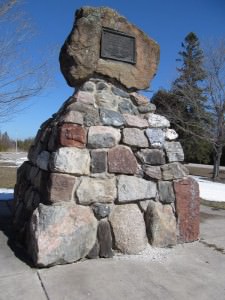 To Frank Rogers,
To Frank Rogers,
Deputy State Highway Commissioner, 1905 to 1913
State Highway Commissioner, 1913-1929
Conceived by the U.P. Road Builders Association, this monument was unveiled on June 4, 1930 with an impressive ceremony attended by several thousand spectators. It was erected to honor the man who worked to develop his 25-year vision of a network of paved roads in Michigan, unequaled in the U.S., and who gave the best years of his life to fulfill that vision. This monument was placed at the junction of US-2 and US-31 (now the corner of Mackinac Trail and M-123) and it remains solid and impressive to this day.
In the small park at the corner of Marquette and State Streets, is the grave of Fr. Marquette. On his marker is written:
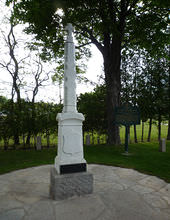 In Memoriam
In Memoriam
Erected by the City of St. Ignace
in 1882, this monument marks the
grave of Reverand Father Jacques
Marquette, S.J., who died the
18th day of May 1675, at the age
of 38 and was buried here, in 1677.
R.I.P.
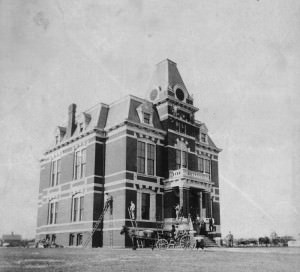 The courthouse in St. Ignace was built in 1882. It was thought that the town’s center would develop right in that vicinity. Already in place near the courthouse square were: the large two-story Wilson House (hotel), a saloon and several retair stores. At that time, the land behind the courthouse was a swamp, which wasn’t drained by the city until years later.
The courthouse in St. Ignace was built in 1882. It was thought that the town’s center would develop right in that vicinity. Already in place near the courthouse square were: the large two-story Wilson House (hotel), a saloon and several retair stores. At that time, the land behind the courthouse was a swamp, which wasn’t drained by the city until years later.
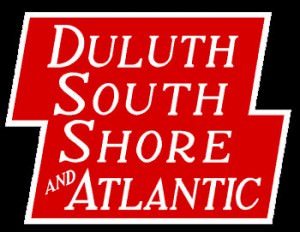 Johnson-named for Otis Johnson-was a station on the Duluth, South Shore and Atlantic Railroad (location at the current corner of M-123 and Kenneth Road). About 1900, William Ross began lumbering in that area and he renamed the settlement Kenneth, for his son. William Ross was the first Postmaster. Sawmills and lumbering brought the population from 40 in 1910 to 165 in 1915. Kenneth had a post office, grocery, general store and a telephone connection by 1917, but population was on the decline by then.
Johnson-named for Otis Johnson-was a station on the Duluth, South Shore and Atlantic Railroad (location at the current corner of M-123 and Kenneth Road). About 1900, William Ross began lumbering in that area and he renamed the settlement Kenneth, for his son. William Ross was the first Postmaster. Sawmills and lumbering brought the population from 40 in 1910 to 165 in 1915. Kenneth had a post office, grocery, general store and a telephone connection by 1917, but population was on the decline by then.
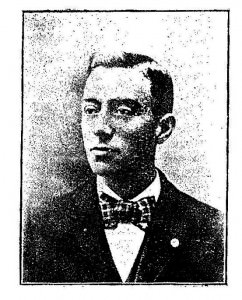 R.A. Servis was born in New York in 1868. He came to St. Ignace and purchased the Louis J. Pauley druggist shop in 1894. There, he prepared prescriptions and transacted the money order business for the Western Express Company. He was a mason and held memberships in Grand Rapids, Petoskey and the Mackinac chapters. Servis was also elected as a school inspector for the Second Ward and was on the Board of Education.
R.A. Servis was born in New York in 1868. He came to St. Ignace and purchased the Louis J. Pauley druggist shop in 1894. There, he prepared prescriptions and transacted the money order business for the Western Express Company. He was a mason and held memberships in Grand Rapids, Petoskey and the Mackinac chapters. Servis was also elected as a school inspector for the Second Ward and was on the Board of Education.
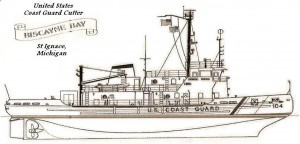 In 1978, the newly-commissioned 140 foot United States Coast Guard Cutter Biscayne Bay (WGTB 104) arrived. This “Bay” class icebreaker has been homeported in St. Ignace her whole life, with her primary area of operation being the Straits of Mackinac and the St. Marys River. She also frequently operates in the St. Clair/Detroit River system, Green Bay, Duluth and Thunder Bay, Ontario. Her primary mission is maintaining tracks in connecting waterways and assisting vessels through the icebound shipping lanes of the Great Lakes. Her other missions include search and rescue, maritime law enforcement, public affairs maritime environmental protection, homeland security, and port, waterways and coastal waterways security.
In 1978, the newly-commissioned 140 foot United States Coast Guard Cutter Biscayne Bay (WGTB 104) arrived. This “Bay” class icebreaker has been homeported in St. Ignace her whole life, with her primary area of operation being the Straits of Mackinac and the St. Marys River. She also frequently operates in the St. Clair/Detroit River system, Green Bay, Duluth and Thunder Bay, Ontario. Her primary mission is maintaining tracks in connecting waterways and assisting vessels through the icebound shipping lanes of the Great Lakes. Her other missions include search and rescue, maritime law enforcement, public affairs maritime environmental protection, homeland security, and port, waterways and coastal waterways security.
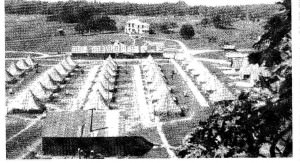 Mackinac Island was home to a Civilian Conservation Corps (CCC) camp from 1933 to 1938. This camp was located a little east of British Landing Road on the Old Early farm. The young CCCs worked on projects for Mackinac Island State Park: landscaping, extensive repairs to Fort Mackinac, clearing brush and they built the Scout Barracks. Pictured at right, the Early home is in the background.
Mackinac Island was home to a Civilian Conservation Corps (CCC) camp from 1933 to 1938. This camp was located a little east of British Landing Road on the Old Early farm. The young CCCs worked on projects for Mackinac Island State Park: landscaping, extensive repairs to Fort Mackinac, clearing brush and they built the Scout Barracks. Pictured at right, the Early home is in the background.
 In Eby’s 1925 guidebook of “Mackinac County of the Straits Country”, the mileage log starts counting as one departs the Michigan State Car Ferry dock #1. At the northern city limits (2.05 miles) is a listing for Hoban’s Creek. “At Hoban’s Creek one enters St. Ignace township. At this point the camper is invited to stop, pitch his tent and feel perfectly welcome. At the right is a fine bathing beach and a mineral spring located in a clump of bushes. This spring resulted from a boring made some years ago to a great depth though the object in sinking the pipe has always been kept in obscurity.”
In Eby’s 1925 guidebook of “Mackinac County of the Straits Country”, the mileage log starts counting as one departs the Michigan State Car Ferry dock #1. At the northern city limits (2.05 miles) is a listing for Hoban’s Creek. “At Hoban’s Creek one enters St. Ignace township. At this point the camper is invited to stop, pitch his tent and feel perfectly welcome. At the right is a fine bathing beach and a mineral spring located in a clump of bushes. This spring resulted from a boring made some years ago to a great depth though the object in sinking the pipe has always been kept in obscurity.”
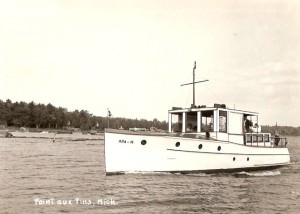 In November 1948, a new dock was being built at Point Aux Pins on the western side of Bois Bland Island. This splendid new pier, contracted to Gene Babcock by the Point Aux Pins Association, was to replace the mailboat dock, damaged when struck by a landing ship in training operations during World War II. The new dock was expected to be finished by June 1, 1949. Pictured at left is the ferry Ada M, as she approaches Bois Blanc Island at Point Aux Pins.
In November 1948, a new dock was being built at Point Aux Pins on the western side of Bois Bland Island. This splendid new pier, contracted to Gene Babcock by the Point Aux Pins Association, was to replace the mailboat dock, damaged when struck by a landing ship in training operations during World War II. The new dock was expected to be finished by June 1, 1949. Pictured at left is the ferry Ada M, as she approaches Bois Blanc Island at Point Aux Pins.
 The last steam-powered train left St. Ignace for Marquette on Monday, June 30, 1947. From 1882, Duluth, South Shore & Atlanta railroad had used steam locomotives to draw freight and passenger trains the length of their tracks. From 1947 on, the four replacement diesel oil fuel-powered locomotives would take care of switching in the yards and haul freight and passenger trains. The old St. Ignace locomotive roundhouse was replaced by a diesel garage located near the downtown depot. This is where the four diesel locomotives would be worked on and housed when not in use.
The last steam-powered train left St. Ignace for Marquette on Monday, June 30, 1947. From 1882, Duluth, South Shore & Atlanta railroad had used steam locomotives to draw freight and passenger trains the length of their tracks. From 1947 on, the four replacement diesel oil fuel-powered locomotives would take care of switching in the yards and haul freight and passenger trains. The old St. Ignace locomotive roundhouse was replaced by a diesel garage located near the downtown depot. This is where the four diesel locomotives would be worked on and housed when not in use.
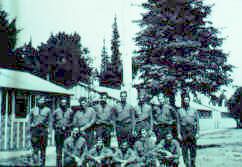 CCC Camp St. Martin was located on the south side of Mackinac County Road 323 (currently Charles Road) between St. Martin Bay of Lake Huron and H-63 (currently Mackinac Trail). The camp was built in 1935 and enrollees worked for $30 a month. Some of their projects were supplying poles for telephone lines and improving Maple Hill fire tower and picnic grounds. They also collected cones for seedling production, fought fires and graded and constructed roads. In 1936, they built restrooms, fireplaces, tables and benches and dug a well at Carp River Campground. Enrollees at this camp organized a 9-piece drum and bugle corps which performed around the area.
CCC Camp St. Martin was located on the south side of Mackinac County Road 323 (currently Charles Road) between St. Martin Bay of Lake Huron and H-63 (currently Mackinac Trail). The camp was built in 1935 and enrollees worked for $30 a month. Some of their projects were supplying poles for telephone lines and improving Maple Hill fire tower and picnic grounds. They also collected cones for seedling production, fought fires and graded and constructed roads. In 1936, they built restrooms, fireplaces, tables and benches and dug a well at Carp River Campground. Enrollees at this camp organized a 9-piece drum and bugle corps which performed around the area.
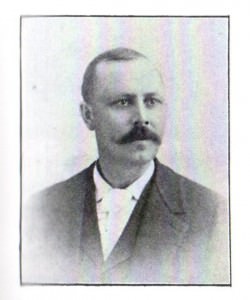 Born in Canada, Harry Wood came to the United states in 1879, working downstate for several years. Arriving in St. Ignace in 1883, he opened his barber shop. He and his tonsorial artists provided a good clean shave for 10 cents, a haircut for 25 cents, a shampoo or sea foam. Also available were bath rooms, for a cold or a hot bath. At one time, Mr. Wood had four chairs and 95 personalized shaving mugs with patrons’ names embossed in gold.
Born in Canada, Harry Wood came to the United states in 1879, working downstate for several years. Arriving in St. Ignace in 1883, he opened his barber shop. He and his tonsorial artists provided a good clean shave for 10 cents, a haircut for 25 cents, a shampoo or sea foam. Also available were bath rooms, for a cold or a hot bath. At one time, Mr. Wood had four chairs and 95 personalized shaving mugs with patrons’ names embossed in gold.
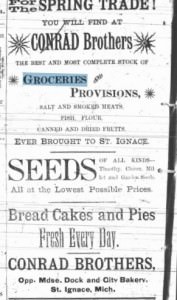 Joseph Wenzel (1881-1959), former purser on the railroad ferry reminisces of times before 1900:
Joseph Wenzel (1881-1959), former purser on the railroad ferry reminisces of times before 1900:
- potatoes sold for 25 to 40 cents a bushel
- eggs were 15 cents a dozen in summer, 25 cents in winter
- flour was $3.50 a barrel
- bread was mostly baked at home
- large can of tomatoes 10 cents or 3 for 25 cents
- milk from the milkman 5 cents per quart
- brined salt pork 6 cents per pound
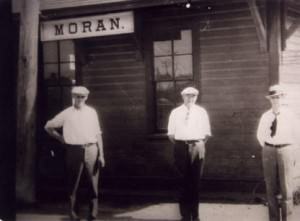 In the February 26, 1948 issue of the Republican News – St. Ignace enterprise was a story from S.F. Christensen (writer of the Brevort Lake column). “Every time I get the blues I get back feeling good again when I think of the time J.D. got himself locked in the depot. It happened like this. One day J.D. was down at the depot waiting to throw the mail aboard when the train gets in. The train was a little late so he steps inside this shed Moran boasts of as a depot to keep warm. Well, he closes the door which automatically locked on the outside which he did not know until he tried to get out when the train pulled in. Yes sir, kids, it was real funny to see him at that windon trying to get our attention to let him out.”
In the February 26, 1948 issue of the Republican News – St. Ignace enterprise was a story from S.F. Christensen (writer of the Brevort Lake column). “Every time I get the blues I get back feeling good again when I think of the time J.D. got himself locked in the depot. It happened like this. One day J.D. was down at the depot waiting to throw the mail aboard when the train gets in. The train was a little late so he steps inside this shed Moran boasts of as a depot to keep warm. Well, he closes the door which automatically locked on the outside which he did not know until he tried to get out when the train pulled in. Yes sir, kids, it was real funny to see him at that windon trying to get our attention to let him out.”
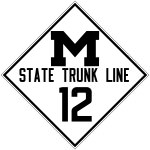 In Eby’s 1925 travelers’ guide, “Mackinac County in the Straits Country”, he describes state highway M-12: “The state trunk line M12 divides at a point 7 7/10 miles north of St. Ignace, the straightaway (now Mackinac Trail) leading through the eastern part of Mackinac County to Sault Ste. Marie; the left turn (now M-123) leading westward through the county to Manistique, Escanaba and points west. Both of these divisions are marked
In Eby’s 1925 travelers’ guide, “Mackinac County in the Straits Country”, he describes state highway M-12: “The state trunk line M12 divides at a point 7 7/10 miles north of St. Ignace, the straightaway (now Mackinac Trail) leading through the eastern part of Mackinac County to Sault Ste. Marie; the left turn (now M-123) leading westward through the county to Manistique, Escanaba and points west. Both of these divisions are marked 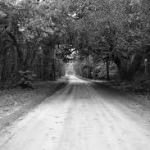 M12.” On another page, Eby refers to the above “left turn” (onto current M123) as the “Allenville turn”…. turn left for Rexton, Engadine, Gould City and Points West.” So portions of this route, M12 also came to be US-2.
M12.” On another page, Eby refers to the above “left turn” (onto current M123) as the “Allenville turn”…. turn left for Rexton, Engadine, Gould City and Points West.” So portions of this route, M12 also came to be US-2.
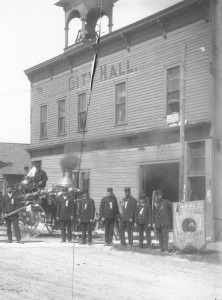 The Women’s Civic League was formed in 1916 to promote city improvement. Its most noteworthy achievement was the establishment of the Civic League Library in 1924. This library started with 100 books donated by civic league members and was set up in the old city hall. For a time, the library was housed with the LaSalle High School Library, but in 1940, its 1000 volumes were moved into the newly-completed Municipal Building. In 1944, the St. Ignace Civic League stated that its most important project was the library and formed a six-member library board. When the Women’s Civic League disbanded in 1969, the library was turned over to the City of St. Ignace. In 1983, the library was moved with its 10,000 volume collection into the former Michigan Bell office on Spring Street. The St. Ignace Public Library moved to its newly-constructed home at 110 West Spruce Street in April 2005.
The Women’s Civic League was formed in 1916 to promote city improvement. Its most noteworthy achievement was the establishment of the Civic League Library in 1924. This library started with 100 books donated by civic league members and was set up in the old city hall. For a time, the library was housed with the LaSalle High School Library, but in 1940, its 1000 volumes were moved into the newly-completed Municipal Building. In 1944, the St. Ignace Civic League stated that its most important project was the library and formed a six-member library board. When the Women’s Civic League disbanded in 1969, the library was turned over to the City of St. Ignace. In 1983, the library was moved with its 10,000 volume collection into the former Michigan Bell office on Spring Street. The St. Ignace Public Library moved to its newly-constructed home at 110 West Spruce Street in April 2005.
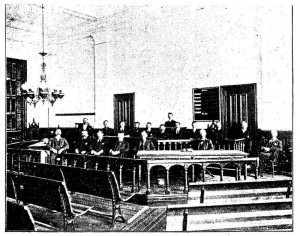 In 1895, the Board of Supervisors of Mackinac County consisted of sixteen members. Four of these supervisors represented the City of St. Ignace. That year, the Chairman of the Board of Supervisors was P.J. Murray, who was elected supervisor from the city’s Third Ward. He was then employed at “St. Ignace National Bank”.
In 1895, the Board of Supervisors of Mackinac County consisted of sixteen members. Four of these supervisors represented the City of St. Ignace. That year, the Chairman of the Board of Supervisors was P.J. Murray, who was elected supervisor from the city’s Third Ward. He was then employed at “St. Ignace National Bank”.

In the November 25, 1948 issue of the Republican News and St. Ignace Enterprise newspaper is a story from Allenville, which coyly mentions no names! When a local farmer backed his car out of the barnyard, he noticed that several of his chickens were aboard. He merely continued on his way, believing that they would jump off. At least three rode all the way to town. He was then seen busily chasing around the depot, trying to recover them.
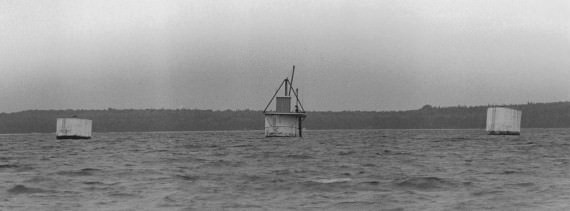 The dolphins – three at first and then four – in Moran Bay were part of a jet fuel delivery system for Kincheloe Air Force Base (also called Kinross). This military base operated from 1943 into 1977, serving Alaska-bound military aircraft. Tanker ships moored at the dolphins, originally topped by a platform. Jet fuel passed through a short underwater pipeline to large storage tanks (eventually numbering eight) on the adjacent shore. At first, tanker trucks hauled the fuel from the St. Ignace storage tanks to the air force base. But by February 1963, an underground pipeline transported the fuel 37 miles to Kincheloe. When this delivery system was no longer needed, the pipeline and storage tanks were removed, but the dolphins remain, causing great curiosity among visitors.
The dolphins – three at first and then four – in Moran Bay were part of a jet fuel delivery system for Kincheloe Air Force Base (also called Kinross). This military base operated from 1943 into 1977, serving Alaska-bound military aircraft. Tanker ships moored at the dolphins, originally topped by a platform. Jet fuel passed through a short underwater pipeline to large storage tanks (eventually numbering eight) on the adjacent shore. At first, tanker trucks hauled the fuel from the St. Ignace storage tanks to the air force base. But by February 1963, an underground pipeline transported the fuel 37 miles to Kincheloe. When this delivery system was no longer needed, the pipeline and storage tanks were removed, but the dolphins remain, causing great curiosity among visitors.
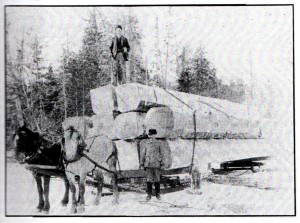 By 1895, though diminished in volume, the lumbering industry was still a factor in the St. Ignace area. Lumbering operations in the woods were carried out in winter: the trees being cut, skidded and piled along the shores of rivers, awaiting spring thaw. The snowmelt added great volumes of high, fast water to streams and rivers. The piles were set free to float downstream to the Big Lake on their way to the mill. After they were released from their winter-spring labors, the ‘jacks would come into town. The Mackinaw jacket was a familiar sight in St. Ignace.
By 1895, though diminished in volume, the lumbering industry was still a factor in the St. Ignace area. Lumbering operations in the woods were carried out in winter: the trees being cut, skidded and piled along the shores of rivers, awaiting spring thaw. The snowmelt added great volumes of high, fast water to streams and rivers. The piles were set free to float downstream to the Big Lake on their way to the mill. After they were released from their winter-spring labors, the ‘jacks would come into town. The Mackinaw jacket was a familiar sight in St. Ignace.
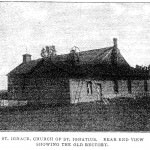 The Catholic church, which came to be know as the Old Mission Church, was built on land donated by Louis Martin, on part of private claim 13. The church’s window frames were built by Oliver Martineau from Carp River. The first service was held there on January 1, 1838. A small log church building already existed on this same land, located just behind the 1837 church. The two co-existed for a time. This site is on State Street, just south of the current corner of McCann. Near the church was a cemetery. Later, those graves were moved to the present Catholic cemetery on Chambers Street near Keightley Street.
The Catholic church, which came to be know as the Old Mission Church, was built on land donated by Louis Martin, on part of private claim 13. The church’s window frames were built by Oliver Martineau from Carp River. The first service was held there on January 1, 1838. A small log church building already existed on this same land, located just behind the 1837 church. The two co-existed for a time. This site is on State Street, just south of the current corner of McCann. Near the church was a cemetery. Later, those graves were moved to the present Catholic cemetery on Chambers Street near Keightley Street.
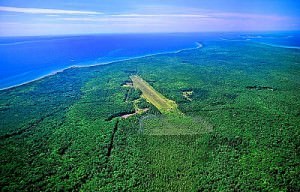 By November 1948, construction was starting on Bois Blanc Island for a landing field. The November 4, 1948 issue of the Republican News and St. Ignace Enterprise newspaper reported, “The new landing field is inland on the western part, three miles from Point Aux Pins. The airstrip will have two runways and one landing strip, one-half mile long and running east-west. The field is being developed by the Conservation Department. Bois Blanc Township has put up $400 to match state money. While the airport will be open to the public, it will be valuable for state use in flying men and equipment to the island in case of fire.”
By November 1948, construction was starting on Bois Blanc Island for a landing field. The November 4, 1948 issue of the Republican News and St. Ignace Enterprise newspaper reported, “The new landing field is inland on the western part, three miles from Point Aux Pins. The airstrip will have two runways and one landing strip, one-half mile long and running east-west. The field is being developed by the Conservation Department. Bois Blanc Township has put up $400 to match state money. While the airport will be open to the public, it will be valuable for state use in flying men and equipment to the island in case of fire.”
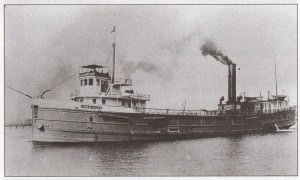 Steamship companies demanded their captains stay on schedule no matter what weather they encountered. This, coupled with fog, sudden storms and heavy traffic on the Great Lakes, resulted in the destruction of thousands of schooners, steamers and barges. One of these was the wooden steamer Eber Ward, built in 1888 at Bay City, Michigan. She sank in the Straits of Mackinac (just west of the future site of the Mackinac Bridge) in April 1909. She struck unexpected ice and sank, with a loss of five lives, on her first trip of the season. This trip was up-bound from Chicago with a cargo of corn which was salvaged that summer and sold to a starch works.
Steamship companies demanded their captains stay on schedule no matter what weather they encountered. This, coupled with fog, sudden storms and heavy traffic on the Great Lakes, resulted in the destruction of thousands of schooners, steamers and barges. One of these was the wooden steamer Eber Ward, built in 1888 at Bay City, Michigan. She sank in the Straits of Mackinac (just west of the future site of the Mackinac Bridge) in April 1909. She struck unexpected ice and sank, with a loss of five lives, on her first trip of the season. This trip was up-bound from Chicago with a cargo of corn which was salvaged that summer and sold to a starch works.
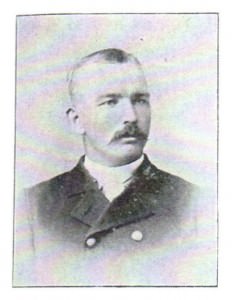 W.P. Chambers owned a cigar and tobacco ship in 1893, across from the DSS&A passenger depot. There, he also sold fruits, confectioneries, stationery, nuts, canned goods and bakery items. Previously he was a lighthouse keeper and built several lighthouses, including the one at Stannard Rock. He also was employed by Mackinac Transportation company, as night watchman and purser of the railroad ferry, Algomah.
W.P. Chambers owned a cigar and tobacco ship in 1893, across from the DSS&A passenger depot. There, he also sold fruits, confectioneries, stationery, nuts, canned goods and bakery items. Previously he was a lighthouse keeper and built several lighthouses, including the one at Stannard Rock. He also was employed by Mackinac Transportation company, as night watchman and purser of the railroad ferry, Algomah.
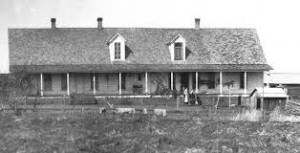 An article published in the November 26, 1931 issue of the local Republican-News, tells about the Poor Farm (located near the current airport). The building had just been enlarged. A covered porch, the length of the building had been added. A 21×36 foot addition had been constructed onto the second floor above the kitchen and dining room which would be used to accommodate 15 more beds. This new room, along with the main sleeping room will be sufficient for all inmates and enable the county to do away with the Epoufette house. At present, all water used is hauled from the bay by a team of horses. The inmates are fed at an average cost of 30 cents per person per day. But it was expected that the cost would be reduced following the next year’s harvest, when nearly 20 acres will be put into crops.
An article published in the November 26, 1931 issue of the local Republican-News, tells about the Poor Farm (located near the current airport). The building had just been enlarged. A covered porch, the length of the building had been added. A 21×36 foot addition had been constructed onto the second floor above the kitchen and dining room which would be used to accommodate 15 more beds. This new room, along with the main sleeping room will be sufficient for all inmates and enable the county to do away with the Epoufette house. At present, all water used is hauled from the bay by a team of horses. The inmates are fed at an average cost of 30 cents per person per day. But it was expected that the cost would be reduced following the next year’s harvest, when nearly 20 acres will be put into crops.
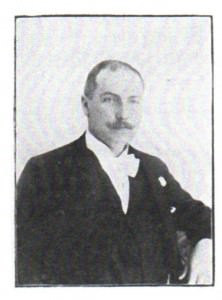 William Spice was the proprietor of the Russell House (formerly called Everett House). This three-story hotel offered lodging, a dining room, billiard room, a bar, balconies and an airy veranda overlooking Mackinac Island. It was located near the railroad and steamship docks (across from the current Public Marina).
William Spice was the proprietor of the Russell House (formerly called Everett House). This three-story hotel offered lodging, a dining room, billiard room, a bar, balconies and an airy veranda overlooking Mackinac Island. It was located near the railroad and steamship docks (across from the current Public Marina).
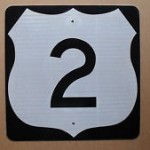
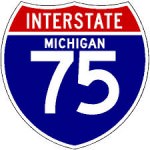 On November 1, 1963, the old road from St. Ignace to Sault Ste. Marie ceased to be United States Highway 2. That road would now be known as Mackinac Trail. The new route, part of the U.S. Interstate System was officially dedicated as part of I-75 as of 11:30 a.m.
On November 1, 1963, the old road from St. Ignace to Sault Ste. Marie ceased to be United States Highway 2. That road would now be known as Mackinac Trail. The new route, part of the U.S. Interstate System was officially dedicated as part of I-75 as of 11:30 a.m.
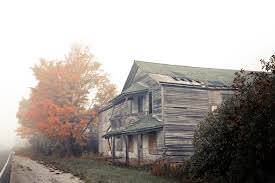 In Brevort Township, along the D.S.S.&A. railroad tracks, a settlement developed. The town was named Allenville for Allen Hulbert, who had convinced the Martel Furnace management to locate there, near their lumber operations. Martel then built a bunkhouse and company store just east of the railroad tracks. J.D. Erskine arrived in that area in 1869. By 1893, Erskine had purchased the Martel building, which he ran as a general store for 50 years.
In Brevort Township, along the D.S.S.&A. railroad tracks, a settlement developed. The town was named Allenville for Allen Hulbert, who had convinced the Martel Furnace management to locate there, near their lumber operations. Martel then built a bunkhouse and company store just east of the railroad tracks. J.D. Erskine arrived in that area in 1869. By 1893, Erskine had purchased the Martel building, which he ran as a general store for 50 years.
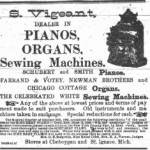 Born in Quebec, S.R. Vigeant came to St. Ignace in 1887. He was the local agent for Singer Sewing Machines. He offered musical instruments: piano, organs, violins, accordians, and others – many of which he sold on installment plans. He would order any musical instrument not in stock and sold sheet music, as well. He and his family lived on the second floor of his store, in a building which he built. One son later became a taxidermist and the other ran the Yellow Front store across from the railroad passenger depot.
Born in Quebec, S.R. Vigeant came to St. Ignace in 1887. He was the local agent for Singer Sewing Machines. He offered musical instruments: piano, organs, violins, accordians, and others – many of which he sold on installment plans. He would order any musical instrument not in stock and sold sheet music, as well. He and his family lived on the second floor of his store, in a building which he built. One son later became a taxidermist and the other ran the Yellow Front store across from the railroad passenger depot.
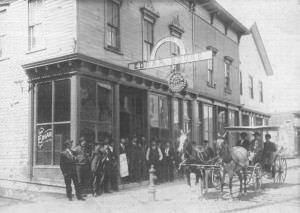 Built on State Street and named the Globe in 1881, this hotel was later purchased and renamed Edgar House, by Thomas Edgar. It offered rooms, with a bar and billiards next door. Despite the proximity of a fire hydrant, it met a fiery end on a below-zero, blizzardy night in February 1908. The firemen spent all night battling the blaze which also destroyed Orth’s Opera House (white building, third north of corner) and several stores. The weary fire fighters did succeed in saving the Murray Brothers store across Goudreau Alley (now Central Hill).
Built on State Street and named the Globe in 1881, this hotel was later purchased and renamed Edgar House, by Thomas Edgar. It offered rooms, with a bar and billiards next door. Despite the proximity of a fire hydrant, it met a fiery end on a below-zero, blizzardy night in February 1908. The firemen spent all night battling the blaze which also destroyed Orth’s Opera House (white building, third north of corner) and several stores. The weary fire fighters did succeed in saving the Murray Brothers store across Goudreau Alley (now Central Hill).
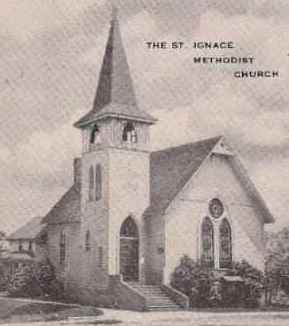 The first Methodist (called Methodist Episcopal and known as “the ME Church) gatherings were held in a small house lent to them by the Mackinaw Lumber Company. Mrs. E.B. Chamberlain was instrumental in its organization. In February 1881, a 20 X 40 foot church building was built just northwest of St. Anthony’s Rock, in one day! It proved to be so small that they constructed a replacement that same year, on a lot in private claim 17, donated by Amable Goudreau. The pictured church, located at the corner of Mary and Moloney (now Goudreau) Streets was ready for the Christmas Eve Service. The present Methodist Church was built in 1959 (in 2005, the St. Ignace Public Library was built right across the street).
The first Methodist (called Methodist Episcopal and known as “the ME Church) gatherings were held in a small house lent to them by the Mackinaw Lumber Company. Mrs. E.B. Chamberlain was instrumental in its organization. In February 1881, a 20 X 40 foot church building was built just northwest of St. Anthony’s Rock, in one day! It proved to be so small that they constructed a replacement that same year, on a lot in private claim 17, donated by Amable Goudreau. The pictured church, located at the corner of Mary and Moloney (now Goudreau) Streets was ready for the Christmas Eve Service. The present Methodist Church was built in 1959 (in 2005, the St. Ignace Public Library was built right across the street).
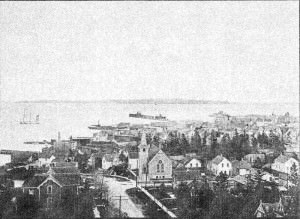 In 1887, seventy leading citizens signed a petition to develop a city water system. That system was installed n 1889 at a cost of $48,000.00. Initially, only 27 hydrants were necessary. By 1890, land was acquired for the standpipe, preparing for the installation of a pressure reservoir for the hilltop. Eventually, a water tower was built on Goudreau Street, just west of Mary Street.
In 1887, seventy leading citizens signed a petition to develop a city water system. That system was installed n 1889 at a cost of $48,000.00. Initially, only 27 hydrants were necessary. By 1890, land was acquired for the standpipe, preparing for the installation of a pressure reservoir for the hilltop. Eventually, a water tower was built on Goudreau Street, just west of Mary Street.
The municipal plant for the water supply and electric power, after being publicly operated for more than 40 years, was sold to the Edison Company. That money was used to retire school bonds. Although the electric power remained in the hands of Edison (Edison Sault and later Cloverland Electric Cooperative), the water department operations were turned back to be the responsibility of the City of St. Ignace early in 1979. (The photo shows the view from the water tower.)
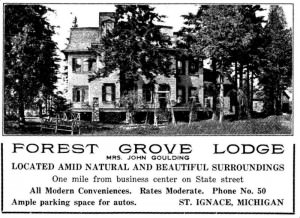 Mrs. Goulding welcomed visitors: as advertised in the 1925 edition of Eby’s vacationers’ guide, “Mackinac County of the Straits Country”.
Mrs. Goulding welcomed visitors: as advertised in the 1925 edition of Eby’s vacationers’ guide, “Mackinac County of the Straits Country”.
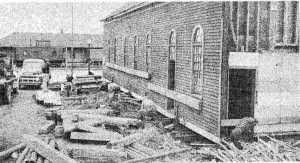 The Old Mission Church was sold by the Catholic Diocese after the new St. Ignatius Loyola Church was built in 1954. The old church building served as a novelty store, a health center, a social hall (called Cloverland Hall and also Old Mission Hall), and a basketball floor was installed in 1950. A parishioner, Catherine Chambers Gleason, purchased, restored and gifted it back to the Church. In 1951, the Church gave the building to the Knights of Columbus, for a museum. By early 1954, the K of C was applying for a permit from the city to move the building and in October the permit was granted. The mover would be Roy Wentworth Trucking Company from Beaverton. The permit estimated that the move would take four hours to get the building on the street, two hours to move it and two hours to get it off the street. The permit also stated that the move would be done by November 5. As it turned out, the actual move took place on Tuesday, November 2, 1954.
The Old Mission Church was sold by the Catholic Diocese after the new St. Ignatius Loyola Church was built in 1954. The old church building served as a novelty store, a health center, a social hall (called Cloverland Hall and also Old Mission Hall), and a basketball floor was installed in 1950. A parishioner, Catherine Chambers Gleason, purchased, restored and gifted it back to the Church. In 1951, the Church gave the building to the Knights of Columbus, for a museum. By early 1954, the K of C was applying for a permit from the city to move the building and in October the permit was granted. The mover would be Roy Wentworth Trucking Company from Beaverton. The permit estimated that the move would take four hours to get the building on the street, two hours to move it and two hours to get it off the street. The permit also stated that the move would be done by November 5. As it turned out, the actual move took place on Tuesday, November 2, 1954.
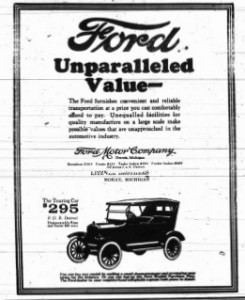 As horseless carriages and automobiles became more dependable and less expensive, “autoists”, as they were called – were itching to expand their driveable horizons. Better roads, road maps, road signs, service stations, garage facilities and overnight motor court and camping accommodations began to make their appearance. With leisure time and some disposable income becoming more universally available, these hardy and determined explorers began heading to Michigan’s Upper Peninsula. Their machines were loaded aboard railroad and car ferries to migrate across the Straits of Mackinac.
As horseless carriages and automobiles became more dependable and less expensive, “autoists”, as they were called – were itching to expand their driveable horizons. Better roads, road maps, road signs, service stations, garage facilities and overnight motor court and camping accommodations began to make their appearance. With leisure time and some disposable income becoming more universally available, these hardy and determined explorers began heading to Michigan’s Upper Peninsula. Their machines were loaded aboard railroad and car ferries to migrate across the Straits of Mackinac.
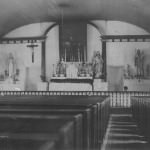 After the Catholic Church was completed in 1837, it was ready for its first service on January 1, 1838. The first child baptized was Agnes LaBute. The first twins baptized were Francis and Catherine, children of Antoine Chevalier. The first marriage was between August Truckey and Margaret Plante on January 22, 1838.
After the Catholic Church was completed in 1837, it was ready for its first service on January 1, 1838. The first child baptized was Agnes LaBute. The first twins baptized were Francis and Catherine, children of Antoine Chevalier. The first marriage was between August Truckey and Margaret Plante on January 22, 1838.
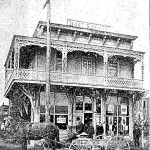 T.J. Cravens (1848-1898) lived above his store, located on the corner of State and Spring Streets. Cravens, born in Kentucky, opened his store in 1885 with a small inventory. Within two years, he was able to expand his stock to include: groceries, fruits, nuts, confectioneries, cigars, smoking and chewing tobaccos, glass and crockery ware, tinware, cooking utensils, fresh bread and bakers’ fancy articles. He offered newspapers from Detroit, Chicago, New York and other large dailies – which he would deliver to his customers upon request. He kept a varied stock of books, maps and stationery for sale. Also on hand was a supply of dry stove wood, which he sold in large or small quantities. He offered free delivery to his customers.
T.J. Cravens (1848-1898) lived above his store, located on the corner of State and Spring Streets. Cravens, born in Kentucky, opened his store in 1885 with a small inventory. Within two years, he was able to expand his stock to include: groceries, fruits, nuts, confectioneries, cigars, smoking and chewing tobaccos, glass and crockery ware, tinware, cooking utensils, fresh bread and bakers’ fancy articles. He offered newspapers from Detroit, Chicago, New York and other large dailies – which he would deliver to his customers upon request. He kept a varied stock of books, maps and stationery for sale. Also on hand was a supply of dry stove wood, which he sold in large or small quantities. He offered free delivery to his customers.
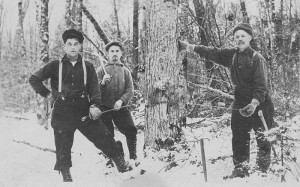 The town of Charles, on St. Martin’s Bay, was settled around a mill and railroad siding of the Sterling Cedar and Lumber Company. The Charles Post Office was established in May 1905, Cassius J. Galbreath as postmaster. By 1910, with a population of 75, Charles had telephone service and the mail stage ran tri-weekly to St. Ignace, passenger fare 50 cents. All cabins and houses in town had names: The Pine, Balsam, Dew Drop In, etc., a visitor reminisces. When the post office closed in June 1923, mail service went to St. Ignace. But there was a general store at least until 1927 and a vacation resort consisting of cottages on the shore of St. Martin’s Bay for many years. In the 1930’s, CCC Camp St. Martin was sited near the old townsite.
The town of Charles, on St. Martin’s Bay, was settled around a mill and railroad siding of the Sterling Cedar and Lumber Company. The Charles Post Office was established in May 1905, Cassius J. Galbreath as postmaster. By 1910, with a population of 75, Charles had telephone service and the mail stage ran tri-weekly to St. Ignace, passenger fare 50 cents. All cabins and houses in town had names: The Pine, Balsam, Dew Drop In, etc., a visitor reminisces. When the post office closed in June 1923, mail service went to St. Ignace. But there was a general store at least until 1927 and a vacation resort consisting of cottages on the shore of St. Martin’s Bay for many years. In the 1930’s, CCC Camp St. Martin was sited near the old townsite.
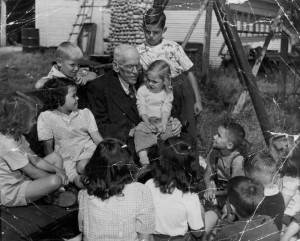 Dr. James Floyd Darby was born in Dresden, New York, August 29, 1871. He arrived in St. Ignace in February 1896, the year after he graduated from Michigan College of Medicine in Detroit. In his 52 years of local practice, he delivered more than 5000 babies. During those years he frequently served as health officer for the city. He passed at the age of 77 years, on September 25, 1948, while listening to the radio in his McCann Street home.
Dr. James Floyd Darby was born in Dresden, New York, August 29, 1871. He arrived in St. Ignace in February 1896, the year after he graduated from Michigan College of Medicine in Detroit. In his 52 years of local practice, he delivered more than 5000 babies. During those years he frequently served as health officer for the city. He passed at the age of 77 years, on September 25, 1948, while listening to the radio in his McCann Street home.
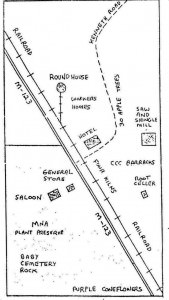 The tiny town of Kenneth had no church, but from time to time, a Methodist minister would visit to give a sermon in the schoolhouse. In the early 1900s, Kenneth consisted of a one-room school, a two-story general store, a boarding house, countless outbuildings, some permanent homes, a sawmill, a railroad roundhouse, and a saloon called Bucket of Blood.
The tiny town of Kenneth had no church, but from time to time, a Methodist minister would visit to give a sermon in the schoolhouse. In the early 1900s, Kenneth consisted of a one-room school, a two-story general store, a boarding house, countless outbuildings, some permanent homes, a sawmill, a railroad roundhouse, and a saloon called Bucket of Blood.
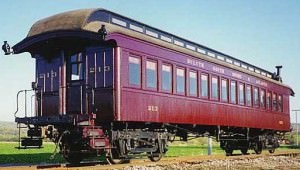 A stop on the Duluth, South Shore and Atlantic Railroad about 23 miles northwest of St. Ignace; Ozark, took its name from the French, ” Aux Arc” (pronounced ozark), meaning “at the bend”. Ozark was settled and named Johnson’s in the very late 1870s/early 1881s. The Martel Furnace maintained charcoal kilns and lumbering operations in this area. By 1910, it was a “flag stop” only, for the railroad – meaning that the trains didn’t automatically stop, but had to be flagged down when needed. The Ozark Quarry still had a presence then. Though the population dwindled, the United States Post Office was open until 1966.
A stop on the Duluth, South Shore and Atlantic Railroad about 23 miles northwest of St. Ignace; Ozark, took its name from the French, ” Aux Arc” (pronounced ozark), meaning “at the bend”. Ozark was settled and named Johnson’s in the very late 1870s/early 1881s. The Martel Furnace maintained charcoal kilns and lumbering operations in this area. By 1910, it was a “flag stop” only, for the railroad – meaning that the trains didn’t automatically stop, but had to be flagged down when needed. The Ozark Quarry still had a presence then. Though the population dwindled, the United States Post Office was open until 1966.
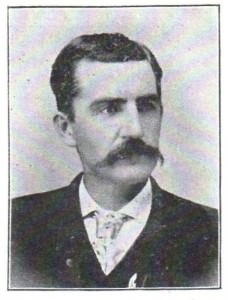 Louis J. Montieth (1848-1899), was born in Illinois and came to St. Ignace in 1881 to build-in partnership-a grocery next door to the hotel located on the corner of State Street and Goudreau Alley (now Central Hill). After a short time, he bought out his partner and moved his grocery a little way down State Street. He sold green and dried fruits, tobaccos, cigars, salted and smoked meats, flour, confectioneries, canned goods, teas, coffees and spices. In St. Ignace, he was elected sheriff and also served as City Marshall. He was a Civil War veteran.
Louis J. Montieth (1848-1899), was born in Illinois and came to St. Ignace in 1881 to build-in partnership-a grocery next door to the hotel located on the corner of State Street and Goudreau Alley (now Central Hill). After a short time, he bought out his partner and moved his grocery a little way down State Street. He sold green and dried fruits, tobaccos, cigars, salted and smoked meats, flour, confectioneries, canned goods, teas, coffees and spices. In St. Ignace, he was elected sheriff and also served as City Marshall. He was a Civil War veteran.
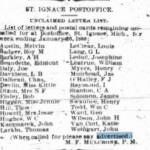 Postmaster Michael Mulcrone placed ads like this one in 1888 to alert residents that they had mail waiting for them at the St. Ignace Post Office. At that time, folks had to pick up their mail. Home delivery didn’t start in this area until 1929 for rural routes and 1946 for house-to-house city carrier routes.
Postmaster Michael Mulcrone placed ads like this one in 1888 to alert residents that they had mail waiting for them at the St. Ignace Post Office. At that time, folks had to pick up their mail. Home delivery didn’t start in this area until 1929 for rural routes and 1946 for house-to-house city carrier routes.
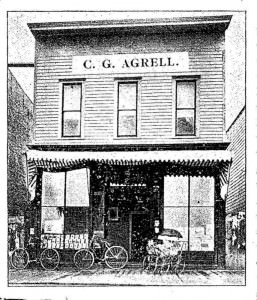 C.G. Agrell, photographer, came to Mackinac Island in 1882 and on to St. Ignace two years later. He had been a photographer since 1875. He showcased specimens of his art in his waiting parlor. He would make likenesses of you or your family and he also offered a select stock of views of St. Ignace and vicinity.
C.G. Agrell, photographer, came to Mackinac Island in 1882 and on to St. Ignace two years later. He had been a photographer since 1875. He showcased specimens of his art in his waiting parlor. He would make likenesses of you or your family and he also offered a select stock of views of St. Ignace and vicinity.
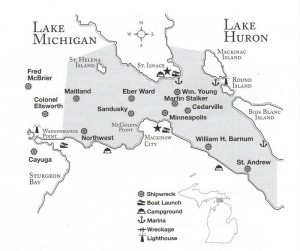 Many schooners, steamers and barges have been destroyed-by sinking or running aground-in the Great Lakes. Sudden storms, fog, heavy traffic and steamship companies’ demands that their captains stay on schedule even in bad weather, have littered the bottoms of the Great Lakes with shipwrecks. These underwater time capsules attract skin and scuba divers from across the United States. The Michigan Underwater Preserve system was created in 1980 through legislation supported and largely drafted by Michigan sport divers. The Straits of Mackinac Shipwreck Preserve encompasses 148 square miles of northern Lake Michigan and into Lake Huron. This preserve runs along parts of the shore of the Upper Peninsula, Lower Peninsula, Mackinac, Round and Bois Blanc Islands. More than 100 years of time are represented among the wrecks lost from 1856 to 1965.
Many schooners, steamers and barges have been destroyed-by sinking or running aground-in the Great Lakes. Sudden storms, fog, heavy traffic and steamship companies’ demands that their captains stay on schedule even in bad weather, have littered the bottoms of the Great Lakes with shipwrecks. These underwater time capsules attract skin and scuba divers from across the United States. The Michigan Underwater Preserve system was created in 1980 through legislation supported and largely drafted by Michigan sport divers. The Straits of Mackinac Shipwreck Preserve encompasses 148 square miles of northern Lake Michigan and into Lake Huron. This preserve runs along parts of the shore of the Upper Peninsula, Lower Peninsula, Mackinac, Round and Bois Blanc Islands. More than 100 years of time are represented among the wrecks lost from 1856 to 1965.
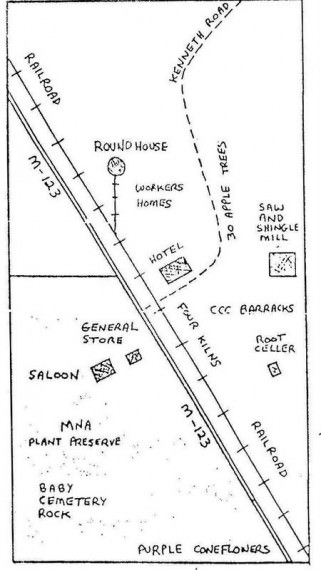 Civilian Conservation Corps’ Camp Kenneth #1664 was located just east of the DSS&A railroad tracks (now the route followed by M-123), and just south of the current Kenneth Road. Three hundred young men lived there and worked in the tree land nearby. They repaired the logged-over areas by planting vast tracts of jack pines and red pines, improving forest roads and clearing streams. By 1937, the men had all been transferred to other sites. All CCC buildings are now gone.
Civilian Conservation Corps’ Camp Kenneth #1664 was located just east of the DSS&A railroad tracks (now the route followed by M-123), and just south of the current Kenneth Road. Three hundred young men lived there and worked in the tree land nearby. They repaired the logged-over areas by planting vast tracts of jack pines and red pines, improving forest roads and clearing streams. By 1937, the men had all been transferred to other sites. All CCC buildings are now gone.
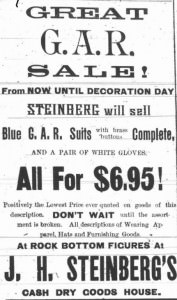 The G.A.R. (Grand Army of the Republic) was a federally-charted group of Civil War Veterans who fought on the Union side. Not all veterans joined the G.A.R. These veterans constituted a powerful political force, and were revered and celebrated by their fellow citizens. They were traditionally present for any veteran-related public events and parades. This ad appeared in the May 21, 1892 issue of the St. Ignace News.
The G.A.R. (Grand Army of the Republic) was a federally-charted group of Civil War Veterans who fought on the Union side. Not all veterans joined the G.A.R. These veterans constituted a powerful political force, and were revered and celebrated by their fellow citizens. They were traditionally present for any veteran-related public events and parades. This ad appeared in the May 21, 1892 issue of the St. Ignace News.
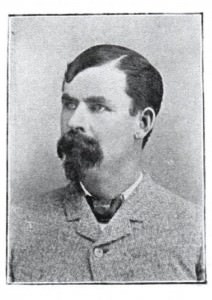 Thomas Dolan was elected as the Mackinac County Sheriff in 1892. Born in Boston in 1850, he served in the U.S. Army for eight years. While in service, he was posted to Ft. Mackinac. After discharge, he returned to the island to work as a saloonkeeper in 1875. Coming to St. Ignace in 1880 to start his own wholesale and retail liquor business, he was elected Second Ward Supervisor for ten years, from 1883. Mr. Dolan lived with his wife and six children upon the Prospect Street bluff.
Thomas Dolan was elected as the Mackinac County Sheriff in 1892. Born in Boston in 1850, he served in the U.S. Army for eight years. While in service, he was posted to Ft. Mackinac. After discharge, he returned to the island to work as a saloonkeeper in 1875. Coming to St. Ignace in 1880 to start his own wholesale and retail liquor business, he was elected Second Ward Supervisor for ten years, from 1883. Mr. Dolan lived with his wife and six children upon the Prospect Street bluff.
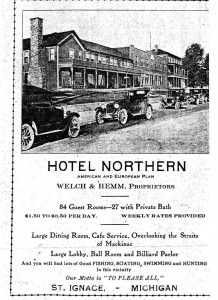 This ad appeared in Eby’s 1925 edition of a vacation guide called, “Mackinac County of the Straits Country: An Official Guide”.
This ad appeared in Eby’s 1925 edition of a vacation guide called, “Mackinac County of the Straits Country: An Official Guide”.
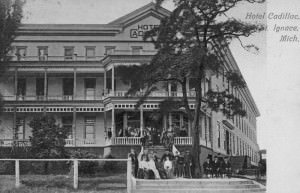 The largest hotel in St. Ignace was the Cadillac, located at the corner of South State and High Streets. The Cadillac burned in 1911 and was not rebuilt.
The largest hotel in St. Ignace was the Cadillac, located at the corner of South State and High Streets. The Cadillac burned in 1911 and was not rebuilt.
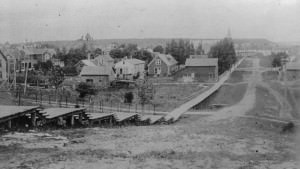 After St. Ignace gained city status (1883) much remained to be done. Early-on, a speed limit of five miles per hour was enacted for carriages, sleighs, wagons and all horse-drawn vehicles. Also in 1883, workers cleaned out a well at the corner of Marley and Portage Streets (by the new Mackinac County Courthouse). The Mackinaw Lumber Company gained acceptance from the St. Ignace Board of Alderman for official status of new streets on their land: Hazelton, Lake, Johnson and Stockbridge.
After St. Ignace gained city status (1883) much remained to be done. Early-on, a speed limit of five miles per hour was enacted for carriages, sleighs, wagons and all horse-drawn vehicles. Also in 1883, workers cleaned out a well at the corner of Marley and Portage Streets (by the new Mackinac County Courthouse). The Mackinaw Lumber Company gained acceptance from the St. Ignace Board of Alderman for official status of new streets on their land: Hazelton, Lake, Johnson and Stockbridge.
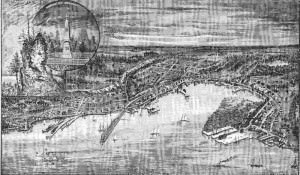 In 1882, Brooks B. Hazelton headed a petition effort to incorporate St. Ignace as a village. At the first-ever election held in town, the following were elected:
In 1882, Brooks B. Hazelton headed a petition effort to incorporate St. Ignace as a village. At the first-ever election held in town, the following were elected:
Brooks B. Hazelton, President; Ambro Bettes, Clerk; Peter A. Paquin, Treasurer;
William D’Arcy, Marshall; Frederick Kruger, Assessor; Trustees: Lewis Ryerse, Ignatius Reagon, Horatio Crane, A.M. Withrow, Hyacinth Chenier, and William Hintz. St. Ignace remained a village only for a short time. In April 1883, a special election obtained approval for Saint Ignace to be incorporated as a Fourth Class City and the first city officials were elected.
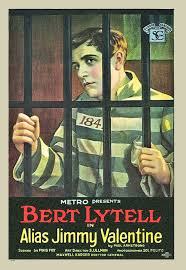 On Thursday, July 4, 1929, the “talkies” came to Vallier’s movie theater for the first time. The remarkable “Voisophone” production of “Alias Jimmy Valentine” starred Lionel Barrymore, William Haines, and Leila Hyams. The theater was packed. Tickets sold for 25 and 50 cents.
On Thursday, July 4, 1929, the “talkies” came to Vallier’s movie theater for the first time. The remarkable “Voisophone” production of “Alias Jimmy Valentine” starred Lionel Barrymore, William Haines, and Leila Hyams. The theater was packed. Tickets sold for 25 and 50 cents.
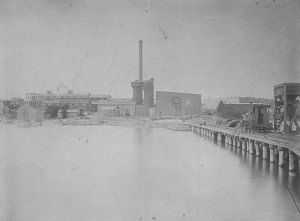 A booklet entitled “City of St. Ignace and Mackinac County for the year 1875” states: “Among the leading industries of St. Ignace may be mentioned a saw-mill, blast furnace, ore docks, etc. It is the headquarters in these parts of the A. Booth Packing Co., who ship daily large consignments of fish. It is also the shipping point of large quantities of lumber, telegraph poles, ties, iron and copper ore and other products of the upper peninsula.”
A booklet entitled “City of St. Ignace and Mackinac County for the year 1875” states: “Among the leading industries of St. Ignace may be mentioned a saw-mill, blast furnace, ore docks, etc. It is the headquarters in these parts of the A. Booth Packing Co., who ship daily large consignments of fish. It is also the shipping point of large quantities of lumber, telegraph poles, ties, iron and copper ore and other products of the upper peninsula.”
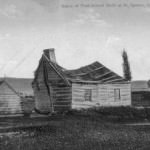 An early schoolhouse was built by the French, on the north shore beyond St. Ignace’s future Third Ward. This photo from about 1900 was taken when the building was approximately 150 years old. The school later served as the home of Chief Sco-bo-gu-no-wis.
An early schoolhouse was built by the French, on the north shore beyond St. Ignace’s future Third Ward. This photo from about 1900 was taken when the building was approximately 150 years old. The school later served as the home of Chief Sco-bo-gu-no-wis.
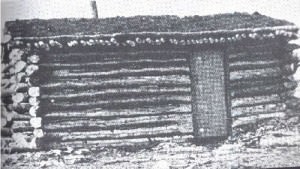 Brevort Township was surveyed in 1839 by H.P. Brevoort, a government surveyor and named in his honor. The first few homesteads were taken around Brevort Lake. In the winter of 1873, six men came from St. Ignace on snowshoes. They were lead by Amber Bettes, a teacher, who helped them to find their land. The others were: Lewis Ryerse, a boat captain; John Rapin, a cooper; William Dorsey; Abel Packard; and William Massey, Sr. They marked their spots and in the spring they returned to build cabins and bring their families to live.
Brevort Township was surveyed in 1839 by H.P. Brevoort, a government surveyor and named in his honor. The first few homesteads were taken around Brevort Lake. In the winter of 1873, six men came from St. Ignace on snowshoes. They were lead by Amber Bettes, a teacher, who helped them to find their land. The others were: Lewis Ryerse, a boat captain; John Rapin, a cooper; William Dorsey; Abel Packard; and William Massey, Sr. They marked their spots and in the spring they returned to build cabins and bring their families to live.
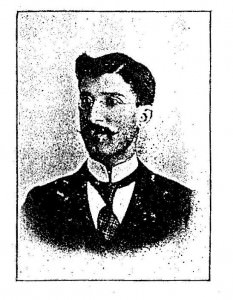 Coming here from Traverse city, J.H. Steinberg started in business in October 1887. He located in a tiny 18 x 36 foot store on the lake-side of State Street across from the foot of Truckey. Steinberg’s sold clothing, household furnishings, trunks and traveling bags, and lumbermen’s goods. He offered a program, whereby a receipt equal to the purchase amount was given to the customer. When the total expenditure totals reached $25, $50, or $100, a premium, such as a handsome rocking chair or other useful item could be redeemed by the customer. In the first seven years, Mr. Steinberg had distributed 5000 premiums, according to a local 1895 publication!
Coming here from Traverse city, J.H. Steinberg started in business in October 1887. He located in a tiny 18 x 36 foot store on the lake-side of State Street across from the foot of Truckey. Steinberg’s sold clothing, household furnishings, trunks and traveling bags, and lumbermen’s goods. He offered a program, whereby a receipt equal to the purchase amount was given to the customer. When the total expenditure totals reached $25, $50, or $100, a premium, such as a handsome rocking chair or other useful item could be redeemed by the customer. In the first seven years, Mr. Steinberg had distributed 5000 premiums, according to a local 1895 publication!
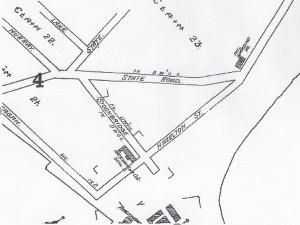 The land in the old Third Ward (at the north part of town) was- early on -owned by the Paquin family, Antoine Paquin arriving her about 1830. This area came to be known as “vides poches” (pronounded vee-posh) or “empty pockets”. Per Emerson Smith’s 1957 book Before The Bridge, this name most likely arose because of the poor collections at neighborhood church gatherings.
The land in the old Third Ward (at the north part of town) was- early on -owned by the Paquin family, Antoine Paquin arriving her about 1830. This area came to be known as “vides poches” (pronounded vee-posh) or “empty pockets”. Per Emerson Smith’s 1957 book Before The Bridge, this name most likely arose because of the poor collections at neighborhood church gatherings.
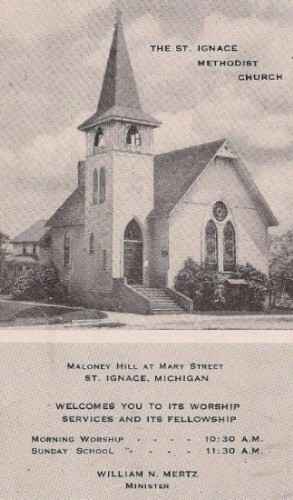 A listing of churches in the May 24, 1887 issue of the St. Ignace News:
A listing of churches in the May 24, 1887 issue of the St. Ignace News:
METHODIST EPISCOPAL – corner of Maloney (now Goudreau) and Mary Streets. Rev. O. Whitmore, pastor.
PRESBYTERIAN – Portage Street at head of Goudreau Alley. Rev. John Ferries, B.A., Pastor.
MARTEL PRESBYTERIAN – Martel Hall. Rev. John Ferries, B.A., pastor.
CONGREGATIONAL – Trucky Street. Rev. C.E. Taggert, pastor.
CATHOLIC – State Street. Rev. Father Koyle, pastor.
BAPTIST – State Street,. Rev. H.H.Hewitt, pastor.
 Michael Lennon advertised stove wood for sale at $1.75 per cord in 1887-88. His ad stated that he was offering hard, dry or green stove wood…phone him at #11. Wooded land could be purchased for $2.00 an acre at that time. Acreage with Maples or other hardwoods might bring $4.00-$10.00 per acre.
Michael Lennon advertised stove wood for sale at $1.75 per cord in 1887-88. His ad stated that he was offering hard, dry or green stove wood…phone him at #11. Wooded land could be purchased for $2.00 an acre at that time. Acreage with Maples or other hardwoods might bring $4.00-$10.00 per acre.
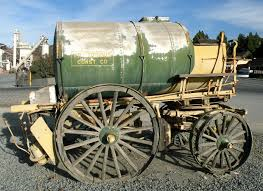 George Litchard ran the Golden Rule Livery business in the early 1900s. He offered many services besides boarding horses and the rental of horses and carriages. In 1918, he held a contract with the City of St. Ignace to plow snow. He cut, stored and sold ice from Lake Huron. Also in 1918, he garnered the contract to sprinkle the city streets, thus performing the service of keeping the dust down. This contract paid $6.00 each day the streets were sprinkled. That summer, the newly-wedded Peter McMichael drove the sprinkler.
George Litchard ran the Golden Rule Livery business in the early 1900s. He offered many services besides boarding horses and the rental of horses and carriages. In 1918, he held a contract with the City of St. Ignace to plow snow. He cut, stored and sold ice from Lake Huron. Also in 1918, he garnered the contract to sprinkle the city streets, thus performing the service of keeping the dust down. This contract paid $6.00 each day the streets were sprinkled. That summer, the newly-wedded Peter McMichael drove the sprinkler.
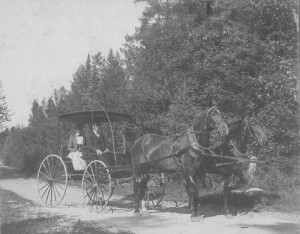 Visitors could hire a carriage and driver for local sight-seeing. This well-appointed rig and team, complete with decorative fly-nets, are heading off to view Castle Rock. Other popular destinations were St. Anthony’s Rock, Fr. Marquette’s grave, Rabbits Back, the old fort trenches on the bluff, Boulevard Drive to Gros Cap, the wigwams on the north shore and island viewing; Mackinac, St. Helena, the two St. Martins, Round and Bois Blanc. Felix Paquin and Harvey Clarke were two of the drivers who would meet visitors at their hotel or boat, for a tour.
Visitors could hire a carriage and driver for local sight-seeing. This well-appointed rig and team, complete with decorative fly-nets, are heading off to view Castle Rock. Other popular destinations were St. Anthony’s Rock, Fr. Marquette’s grave, Rabbits Back, the old fort trenches on the bluff, Boulevard Drive to Gros Cap, the wigwams on the north shore and island viewing; Mackinac, St. Helena, the two St. Martins, Round and Bois Blanc. Felix Paquin and Harvey Clarke were two of the drivers who would meet visitors at their hotel or boat, for a tour.
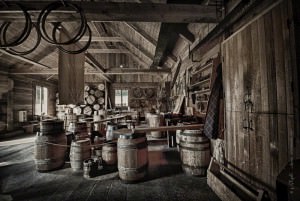 The commercial fishing industry required wood for barrels and coopers to build those barrels. The fish were preserved by salting them in the barrels. Barrels of fish were transported via ship or train to Chicago, Buffalo and other eastern ports. A barrel of fish sold for $10.00.
The commercial fishing industry required wood for barrels and coopers to build those barrels. The fish were preserved by salting them in the barrels. Barrels of fish were transported via ship or train to Chicago, Buffalo and other eastern ports. A barrel of fish sold for $10.00.
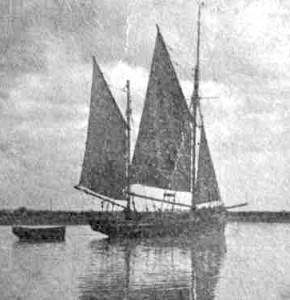 Overland roads being primitive and difficult to travel meant the water was most often used to move freight and passengers. By the 1870s, ferries were sailing along the coastline of the Upper Peninsula to serve islands, small towns and remote fishing and lumbering camps. Excitement was high when the store ship arrived! Just think of the possibilities of things to be purchased from the water-borne peddlar!
Overland roads being primitive and difficult to travel meant the water was most often used to move freight and passengers. By the 1870s, ferries were sailing along the coastline of the Upper Peninsula to serve islands, small towns and remote fishing and lumbering camps. Excitement was high when the store ship arrived! Just think of the possibilities of things to be purchased from the water-borne peddlar!
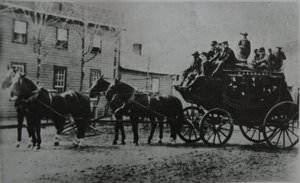 The early stage routes were usually operated by livery stables. Traveling over narrow roads was hard going, with horses pulling the heavy coaches through mudholes or deep sand. The road west from St. Ignace was known as the Peter White Trail. Stages ran this route to Brevort, Epoufette, Naubinway, Gilchrist, Rexton and other points twice weekly. Another route ran north and east to the Les Cheneaux area through the Simmons Settlement.
The early stage routes were usually operated by livery stables. Traveling over narrow roads was hard going, with horses pulling the heavy coaches through mudholes or deep sand. The road west from St. Ignace was known as the Peter White Trail. Stages ran this route to Brevort, Epoufette, Naubinway, Gilchrist, Rexton and other points twice weekly. Another route ran north and east to the Les Cheneaux area through the Simmons Settlement.
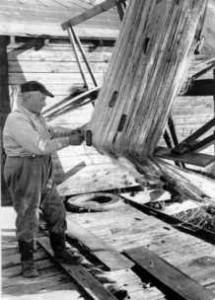 The town of Brevort was initially called “The Warehouse”. This place was a supply depot for the Mackinaw Lumber Company. Swedish families then emigrated there to engage in commercial fishing. Gustafson, Matson, LaVake, Haffney, Vogt, Hallberg, Carlson and Holmberg were the family names of some of these early fishermen.
The town of Brevort was initially called “The Warehouse”. This place was a supply depot for the Mackinaw Lumber Company. Swedish families then emigrated there to engage in commercial fishing. Gustafson, Matson, LaVake, Haffney, Vogt, Hallberg, Carlson and Holmberg were the family names of some of these early fishermen.
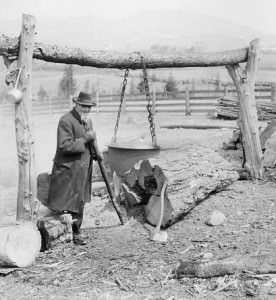 Maple sugar was an important article of trade in the early days. People living in this region depended on it for their own sugar supply. It is said that in one year more than 300,000 pounds were shipped from St. Helena and Mackinac Islands, much of it was made by local Native Americans.
Maple sugar was an important article of trade in the early days. People living in this region depended on it for their own sugar supply. It is said that in one year more than 300,000 pounds were shipped from St. Helena and Mackinac Islands, much of it was made by local Native Americans.
 Thomas Hoban homesteaded a 60-acre tract of land (circa 1845) in what is now called Evergreen Shores. Hoban’s Creek is named for him. A grist mill was built by two Sharbonow brothers about 1850 on Hoban’s Creek. Later, this land was the site of the county poor farm and now the Mackinac County Airport.
Thomas Hoban homesteaded a 60-acre tract of land (circa 1845) in what is now called Evergreen Shores. Hoban’s Creek is named for him. A grist mill was built by two Sharbonow brothers about 1850 on Hoban’s Creek. Later, this land was the site of the county poor farm and now the Mackinac County Airport.

This following information was placed in the January 26, 1950 issue of The Republican News-St. Ignace Enterprise. “An artist’s conception of the proposed bridge across the Straits of Mackinac is shown above. This would be the largest bridge in the world and according to the Mackinac Bridge Citizens Committee, it can be built at no cost or obligation to the State of Michigan. The committee is currently spearheading a movement to bring about a re-creation by the state legislature of a “Bridge Authority.” Compete details regarding the bridge project may be obtained by sending a card or letter to the Mackinac Bridge Citizens Committee, Stroh Building, Detroit 26.”
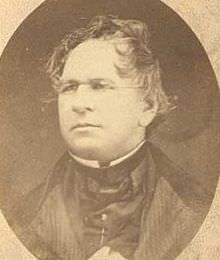 Henry Schoolcraft (1792-1864) was the Indian agent in this area from 1833 to 1841. He was also a scientist, industrialist, mining engineer, explorer, historian, educator, legislator, social reformer, religious leader, editor, author, painter and poet. Because he was considered an authority on Indian history, language, and legends; Longfellow wrote the story of Hiawatha based on his writings.
Henry Schoolcraft (1792-1864) was the Indian agent in this area from 1833 to 1841. He was also a scientist, industrialist, mining engineer, explorer, historian, educator, legislator, social reformer, religious leader, editor, author, painter and poet. Because he was considered an authority on Indian history, language, and legends; Longfellow wrote the story of Hiawatha based on his writings.
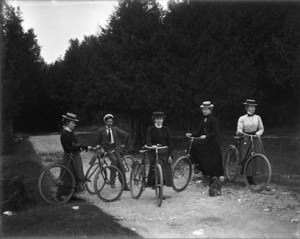 In the late 1800s, bicycles became available and were very popular; St. Ignace had a bicycle club. Cycles were particularly handy here, as the city ran the entire shore length. One could purchase “a wheel”, as they were known, from Dr. G.H. Velhuis’ cycle shop. His business was an agency for the American Rambler cycle. By 1892, the City of St. Ignace had enacted an ordinance prohibiting the use of bicycles on city sidewalks.
In the late 1800s, bicycles became available and were very popular; St. Ignace had a bicycle club. Cycles were particularly handy here, as the city ran the entire shore length. One could purchase “a wheel”, as they were known, from Dr. G.H. Velhuis’ cycle shop. His business was an agency for the American Rambler cycle. By 1892, the City of St. Ignace had enacted an ordinance prohibiting the use of bicycles on city sidewalks.
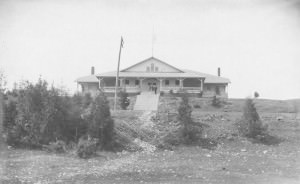 The St. Ignace area was highly regarded as to its health-enhancing climate. Spending time here appealed to those seeking relief from hay fever and asthma. A group of local businessmen formed the Hay Fever Association to promote the resort business. They sponsored the erection of The Pavilion, on the bluff at the south end of town. This new auditorium was intended to serve a large and growing tourist trade. Not proving to be profitable, it ended up being used for entertainment and public purposes until it burned in 1932. The steps (in photo at right) remain on South State Street near Hombach.
The St. Ignace area was highly regarded as to its health-enhancing climate. Spending time here appealed to those seeking relief from hay fever and asthma. A group of local businessmen formed the Hay Fever Association to promote the resort business. They sponsored the erection of The Pavilion, on the bluff at the south end of town. This new auditorium was intended to serve a large and growing tourist trade. Not proving to be profitable, it ended up being used for entertainment and public purposes until it burned in 1932. The steps (in photo at right) remain on South State Street near Hombach.
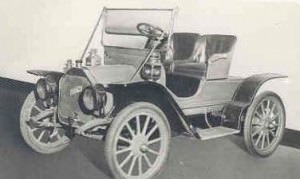 According to Emerson Smith’s 1957 book, Before the Bridge, a local resident, Charles Hudson, drove his newly-purchased automobile home from a dealer in Flint in 1911. He had to detour via Charlevoix, Mackinaw City and then to Cheboygan, where he and his auto boarded a D&C steamship to St. Ignace. He was a Spanish American War veteran and had traveled with Ringling Brothers circus, making daily balloon ascensions. He continued to entertain locally by making ascensions during community events; once landing on a house!
According to Emerson Smith’s 1957 book, Before the Bridge, a local resident, Charles Hudson, drove his newly-purchased automobile home from a dealer in Flint in 1911. He had to detour via Charlevoix, Mackinaw City and then to Cheboygan, where he and his auto boarded a D&C steamship to St. Ignace. He was a Spanish American War veteran and had traveled with Ringling Brothers circus, making daily balloon ascensions. He continued to entertain locally by making ascensions during community events; once landing on a house!
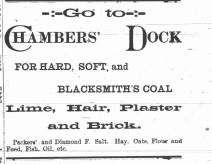 Established in 1870, the Chamber Brothers’ general store, dealing in coal, dry goods, feed and groceries, was housed on their large dock in mid-town. The Chambers store was also an agent for Drummond Line and for Hart Steamship Line. A nephew operated the business in later years. The Chambers’ dock was sold to the Michigan State Car Ferry System in 1923.
Established in 1870, the Chamber Brothers’ general store, dealing in coal, dry goods, feed and groceries, was housed on their large dock in mid-town. The Chambers store was also an agent for Drummond Line and for Hart Steamship Line. A nephew operated the business in later years. The Chambers’ dock was sold to the Michigan State Car Ferry System in 1923.
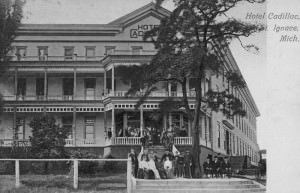 The Sherwood Hotel, built in 1888, was located directly across from the Merchandise Dock, where passenger ships and trains arrived. Later sold and renamed Cadillac Hotel, it had 200 rooms and a large dining room.
The Sherwood Hotel, built in 1888, was located directly across from the Merchandise Dock, where passenger ships and trains arrived. Later sold and renamed Cadillac Hotel, it had 200 rooms and a large dining room.
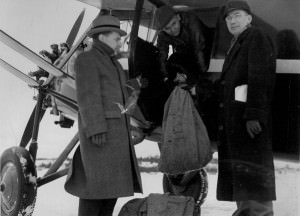
As airplanes became more numerous and more dependable, the United States Post Office made use of them to haul the mail. Mackinac Island’s mail was shuttled to and from St. Ignace. In the photo, St. Ignace Postmaster, Oliver Boynton, Jr. (right) and an unidentified man assist pilot Bud Hammond (in plane) in loading bags of mail bound for the island, circa 1939-40.
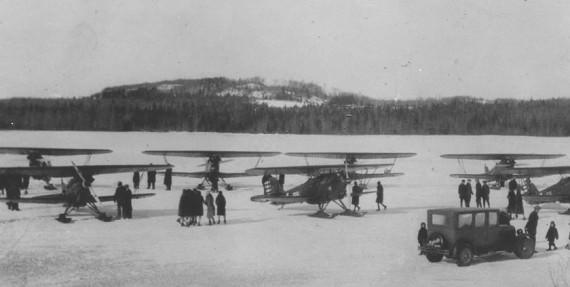 The local airport, Wing Field, was created by the Wing family on land they had used to grow strawberries and which had formerly been the site of the poor farm. The Wing family sold the airport to Mackinac County about 1932 and a terminal was built in 1934. The photo shows United States Army planes from Fort Brady at Sault Ste. Marie that were flown here to test new skis which had been fabricated at Wing’s Garage.
The local airport, Wing Field, was created by the Wing family on land they had used to grow strawberries and which had formerly been the site of the poor farm. The Wing family sold the airport to Mackinac County about 1932 and a terminal was built in 1934. The photo shows United States Army planes from Fort Brady at Sault Ste. Marie that were flown here to test new skis which had been fabricated at Wing’s Garage.
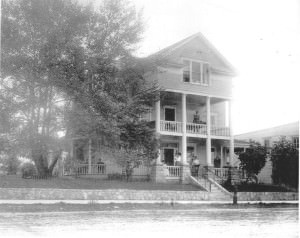 Many of the mid-nineteenth century immigrants who settled in the St. Ignace area came from Ireland. Among them were members of the Chambers family from County Mayo. Members of this family prospered as businessmen and held city, township and county offices. This stately home (shown in the early 1900’s) was built in the center of downtown and was directly across from their large commercial dock.
Many of the mid-nineteenth century immigrants who settled in the St. Ignace area came from Ireland. Among them were members of the Chambers family from County Mayo. Members of this family prospered as businessmen and held city, township and county offices. This stately home (shown in the early 1900’s) was built in the center of downtown and was directly across from their large commercial dock.
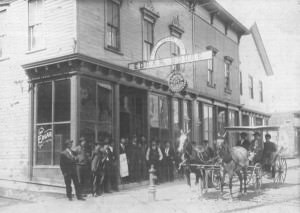 St. Ignace was home to numerous hostelries over the years, with owners and names changing in an almost constant blur! The Edgar House (formerly The Globe, built in 1881) offered rooms upstairs and a bar on the ground floor. In February 1908, it was consumed by fire, along with the nearby opera house and several stores. The firemen were up against tough odds: fire-fighting for many hours in near-zero temperatures and a blinding snow blizzard. They did manage to save the Murray Brothers’ store, located across the side street, Central Hill.
St. Ignace was home to numerous hostelries over the years, with owners and names changing in an almost constant blur! The Edgar House (formerly The Globe, built in 1881) offered rooms upstairs and a bar on the ground floor. In February 1908, it was consumed by fire, along with the nearby opera house and several stores. The firemen were up against tough odds: fire-fighting for many hours in near-zero temperatures and a blinding snow blizzard. They did manage to save the Murray Brothers’ store, located across the side street, Central Hill.
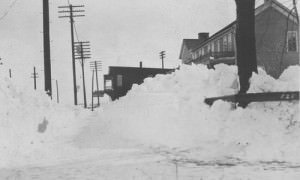 This photo (takes between 1914 & 1921) shows the neatly shoveled sidewalk in front of the Dunham Hotel (right foreground). The photographer was standing on South State Street looking south toward Spring Street. On that corner, the two-story building (center of photo) was at various times used as a restaurant, grocery, ice cream parlor and an insurance agency. The heavily-burdened utility poles were later re-located to the alley behind the downtown businesses.
This photo (takes between 1914 & 1921) shows the neatly shoveled sidewalk in front of the Dunham Hotel (right foreground). The photographer was standing on South State Street looking south toward Spring Street. On that corner, the two-story building (center of photo) was at various times used as a restaurant, grocery, ice cream parlor and an insurance agency. The heavily-burdened utility poles were later re-located to the alley behind the downtown businesses.
 Francis Palms was a Detroit-area financier and lumberman with connections to the Detroit, Mackinaw & Marquette Railroad. At about 19 miles northwest of St. Ignace along the D,M&M right-of-way, the settlement of Palms was named for him. The D,M&M Railroad’s right-of-way and rolling stock was later purchased by the Duluth, South Shore and Atlantic Railroad. In 1884, the United States Post Office came to town-but was officially designated as Pines, Michigan-not Palms!
Francis Palms was a Detroit-area financier and lumberman with connections to the Detroit, Mackinaw & Marquette Railroad. At about 19 miles northwest of St. Ignace along the D,M&M right-of-way, the settlement of Palms was named for him. The D,M&M Railroad’s right-of-way and rolling stock was later purchased by the Duluth, South Shore and Atlantic Railroad. In 1884, the United States Post Office came to town-but was officially designated as Pines, Michigan-not Palms!
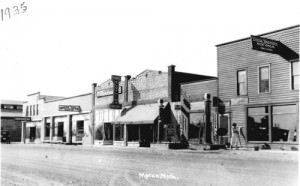 Jacob City was colonized in the early 1880s by the German Land Company for agricultural purposes. The set-up was for a town center and individual farms to surround it in the outlying area. When Mr. Jacob was accused of fraud and ousted from the company, William B. Moran loaned money to the community and the town was renamed in his honor. The picture of Moran was taken circa 1935.
Jacob City was colonized in the early 1880s by the German Land Company for agricultural purposes. The set-up was for a town center and individual farms to surround it in the outlying area. When Mr. Jacob was accused of fraud and ousted from the company, William B. Moran loaned money to the community and the town was renamed in his honor. The picture of Moran was taken circa 1935.
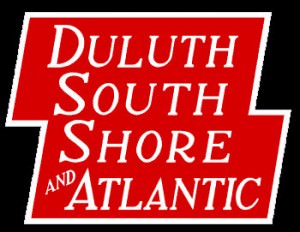 The railroad which served St. Ignace was the Duluth, South Shore and Atlantic Railroad (DSS&A). From St. Ignace northwest, the stations were: Allenville, 10 miles; Moran, 11 miles; Palms (or Pines) 19 miles; Ozark, 23 miles; Trout Lake, 27 miles; Hendrie, 36 miles; and Soo Junction, 43 miles.
The railroad which served St. Ignace was the Duluth, South Shore and Atlantic Railroad (DSS&A). From St. Ignace northwest, the stations were: Allenville, 10 miles; Moran, 11 miles; Palms (or Pines) 19 miles; Ozark, 23 miles; Trout Lake, 27 miles; Hendrie, 36 miles; and Soo Junction, 43 miles.
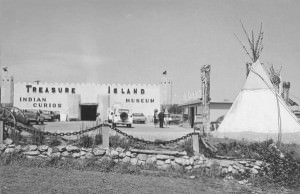 This building was built to be a fish processing plant, Later, it served as a souvenir store, then as a gift shop/museum (pictured) with a huge aquarium of fish from the Great Lakes. It is currently serving as a ferry terminal.
This building was built to be a fish processing plant, Later, it served as a souvenir store, then as a gift shop/museum (pictured) with a huge aquarium of fish from the Great Lakes. It is currently serving as a ferry terminal.
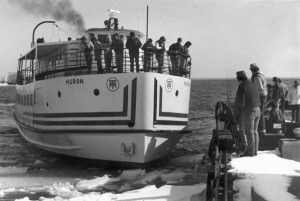 Mid-century, the Arnold Transit Co. gathered a fleet of new steel-hulled diesel-powered ferries to transport freight and passengers to Mackinac Island. The “ladies”, named Huron (1955), Ottawa (1959), Algomah (1961), and Chippewa (1962) arrived to start their decades-long service.
Mid-century, the Arnold Transit Co. gathered a fleet of new steel-hulled diesel-powered ferries to transport freight and passengers to Mackinac Island. The “ladies”, named Huron (1955), Ottawa (1959), Algomah (1961), and Chippewa (1962) arrived to start their decades-long service.
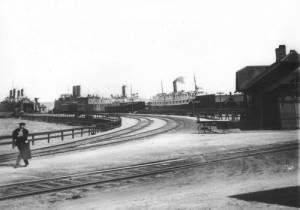 On a Sunday morning in early October 1892, DSS&A railroad brakeman, Thomas McGregor, had a close call. The engineer was slowly backing locomotive 301 near the passenger depot. McGregor attempted to board the tender, but missed his foothold on the brake beam, falling-luckily-parallel between the tracks. The timely shouting of Miss Lily Gennell alerted the engineer to McGregor’s plight. When the train fortunately stopped, McGregor was already underneath. He was taken to the Russell House, put into bed and a physician summoned. He was found to be severely bruised, but received no internal injuries. Had the fire-box passed over him, he would have been crushed. Miss Gennell saved his life.
On a Sunday morning in early October 1892, DSS&A railroad brakeman, Thomas McGregor, had a close call. The engineer was slowly backing locomotive 301 near the passenger depot. McGregor attempted to board the tender, but missed his foothold on the brake beam, falling-luckily-parallel between the tracks. The timely shouting of Miss Lily Gennell alerted the engineer to McGregor’s plight. When the train fortunately stopped, McGregor was already underneath. He was taken to the Russell House, put into bed and a physician summoned. He was found to be severely bruised, but received no internal injuries. Had the fire-box passed over him, he would have been crushed. Miss Gennell saved his life.
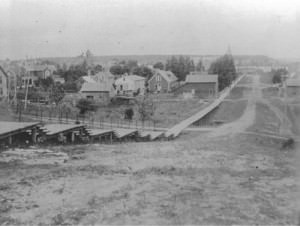 This wooden sidewalk travels down the Church Street hill from the Ursuline Academy and Convent toward the St. Ignatius Church at the north end. The old LaSalle High School tower is visible on the horizon.
This wooden sidewalk travels down the Church Street hill from the Ursuline Academy and Convent toward the St. Ignatius Church at the north end. The old LaSalle High School tower is visible on the horizon.
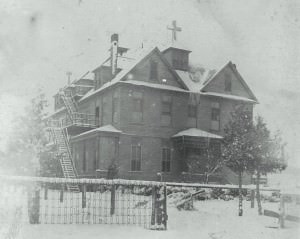 Established by three Ursuline Sisters from Chatham, Ontario, with fundraising help by
Established by three Ursuline Sisters from Chatham, Ontario, with fundraising help by
St. Ignatius Loyola parishioners, the Academy of Our Lady of the Straits opened on September 8, 1897 with 60 students. It became known as the Convent and originally graduated high school students, but was an elementary school when it closed in 1972.
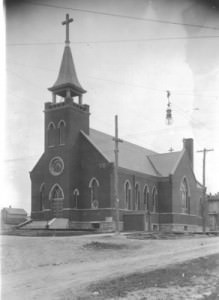 In 1904, the new St. Ignatius Loyola Catholic Church was built at the corner of Church and Spring Streets. It was enlarged and a basement added in 1948-49. In 1942, a fire forced the congregation to move back into its Old Mission Church, while repairs were made.
In 1904, the new St. Ignatius Loyola Catholic Church was built at the corner of Church and Spring Streets. It was enlarged and a basement added in 1948-49. In 1942, a fire forced the congregation to move back into its Old Mission Church, while repairs were made.
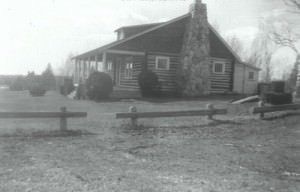 The St. Ignace Golf and Country Club was organized about 1926 and developed through the late 1920s and into the early 1930s. This log clubhouse was erected in the late 1920s. In 1948, the nine-hole course became the property of the City of St. Ignace. This clubhouse was razed about 1998, leaving only the chimney as a reminder.
The St. Ignace Golf and Country Club was organized about 1926 and developed through the late 1920s and into the early 1930s. This log clubhouse was erected in the late 1920s. In 1948, the nine-hole course became the property of the City of St. Ignace. This clubhouse was razed about 1998, leaving only the chimney as a reminder.
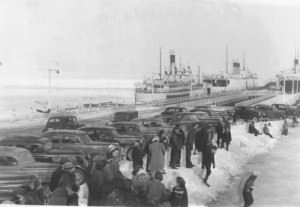 Shown in 1938-39, skaters head out to use the ice rink previously flooded by municipal employees. This rink was on the shore adjacent to State Car Ferry Dock #2 (now the Public Marina area.) Several of the car ferries await the spring thaw.
Shown in 1938-39, skaters head out to use the ice rink previously flooded by municipal employees. This rink was on the shore adjacent to State Car Ferry Dock #2 (now the Public Marina area.) Several of the car ferries await the spring thaw.
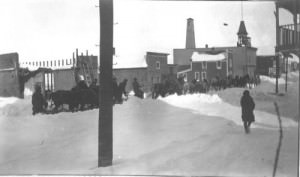 Snow removal was done with shovels and horse-drawn plows. This ten-horse hitch is working on North State Street, heading south. The porch balcony on the right is Snyder’s hotel which was razed to make way for the current Municipal Building. The former City Hall and fire department is shown above the pedestrian’s head with the bell tower in front and a fire siren tower at its rear, that building housed the city’s offices from the early 1880s to 1939.
Snow removal was done with shovels and horse-drawn plows. This ten-horse hitch is working on North State Street, heading south. The porch balcony on the right is Snyder’s hotel which was razed to make way for the current Municipal Building. The former City Hall and fire department is shown above the pedestrian’s head with the bell tower in front and a fire siren tower at its rear, that building housed the city’s offices from the early 1880s to 1939.
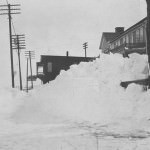 Winter in St. Ignace…Ice and snow everywhere you look! The following is from the March 29, 1934 issue of the Republican News-St. Ignace Enterprise:
Winter in St. Ignace…Ice and snow everywhere you look! The following is from the March 29, 1934 issue of the Republican News-St. Ignace Enterprise:
“The ice on the lakes shows no signs of breaking up as yet. Two of our local people have automobiles and drive them on the ice across the bay, and even to Bois Blanc. Raymond and Clark O’Brien have been cutting wood at Bois Blanc and pulling sleigh-loads of it across the big lake to the Island, behind their automobile. Some of the local merchants have received merchandise from Mackinaw City and Cheboygan by truck. It has been many years since we have had such fine crossing, and brings to mind the winter of 1923, when the last crossing to St. Ignace by horse was made during the last week in April.”
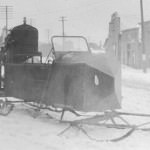 This early version of Chester Wing’s motorized sled is shown parked on North State Street in front of Wing’s Garage (present site of Fort de Buade Museum).
This early version of Chester Wing’s motorized sled is shown parked on North State Street in front of Wing’s Garage (present site of Fort de Buade Museum).
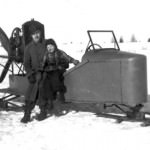 Chester Wing tinkered with his motor sled and met with considerable success in marketing it. This photo (left) shows members of the Hagen family with a model from the 1940s.
Chester Wing tinkered with his motor sled and met with considerable success in marketing it. This photo (left) shows members of the Hagen family with a model from the 1940s.
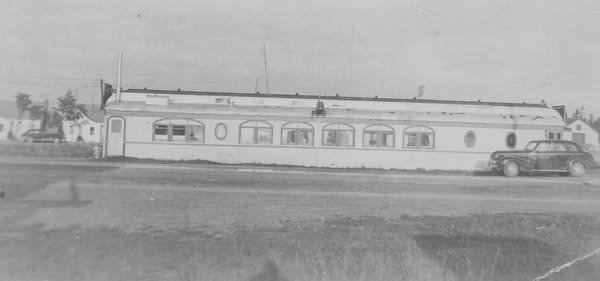 Because of the major railroad presence in St. Ignace, surplus Pullman cars were readily available here. Two of these were used for business locations. Pictured here is the bar which was located on North State Street near Glashaw Street. The other Pullman also served as a bar further north, near Paquin and Hazelton Streets.
Because of the major railroad presence in St. Ignace, surplus Pullman cars were readily available here. Two of these were used for business locations. Pictured here is the bar which was located on North State Street near Glashaw Street. The other Pullman also served as a bar further north, near Paquin and Hazelton Streets.
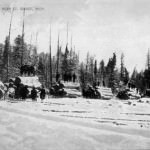 For a short time, there was a small settlement called Greene along the Duluth, South Shore and Atlantic Railroad’s right-of-way about three miles northwest of Moran. This place (located at M-123 and Greene Road) received its mail at Allenville.
For a short time, there was a small settlement called Greene along the Duluth, South Shore and Atlantic Railroad’s right-of-way about three miles northwest of Moran. This place (located at M-123 and Greene Road) received its mail at Allenville.
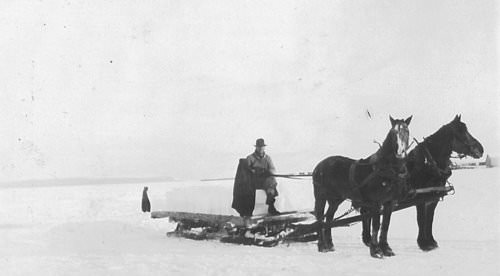 Harvested ice cakes were measured in cords for sale to businesses which sold fish, meat and other perishables. Some ice was sent away via railroad and by ship. Home delivery in the St. Ignace area began about 1900.
Harvested ice cakes were measured in cords for sale to businesses which sold fish, meat and other perishables. Some ice was sent away via railroad and by ship. Home delivery in the St. Ignace area began about 1900.
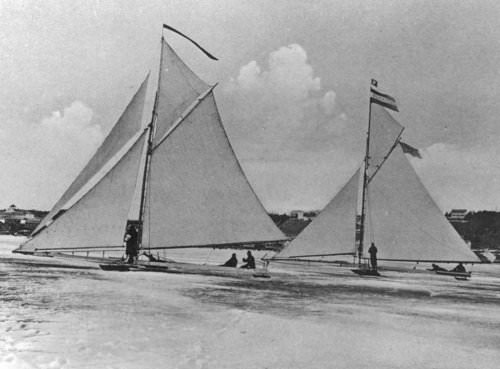 Winter fun included iceboat racing in the Straits area. A track was set up to race from the Mill Slip to the Ore Dock (currently the Marina area).
Winter fun included iceboat racing in the Straits area. A track was set up to race from the Mill Slip to the Ore Dock (currently the Marina area).
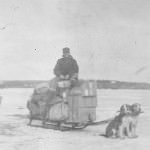
Mail was delivered via boats in summer and by dogsled after ice formed. By the 1930s, airplanes were handling wintertime mail. At right, Isaac Paquin & his dog heading to Mackinac Island.
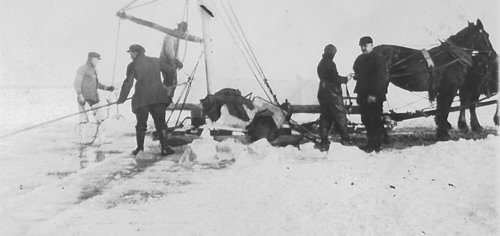 After the lake froze, the ice harvest began. Ice was cut into 22-inch squares using regular one-man crosscut saws. These ice cakes were lifted out of the water and loaded on horse-drawn sleighs for transport to ice houses along the beach. The ice cakes were packed between thick layers of sawdust.
After the lake froze, the ice harvest began. Ice was cut into 22-inch squares using regular one-man crosscut saws. These ice cakes were lifted out of the water and loaded on horse-drawn sleighs for transport to ice houses along the beach. The ice cakes were packed between thick layers of sawdust.
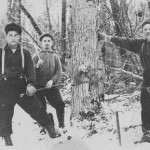 The railroad headed out of St. Ignace to the northwest (along the present M-123) toward Trout Lake, which was also an important railroad hub. Trout Lake was settled in 1881 at the junction of two railroads. It became a trading center for lumber camps in that area.
The railroad headed out of St. Ignace to the northwest (along the present M-123) toward Trout Lake, which was also an important railroad hub. Trout Lake was settled in 1881 at the junction of two railroads. It became a trading center for lumber camps in that area.
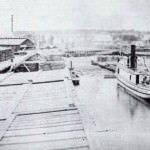 Lumbering was the catalyst for St. Ignace’s population “boom” in the late 1800s. Mackinaw Lumber Company built the first sawmill here in the late 1870’s. This mill was moved here from Singapore, Michigan (near Saugatuck), by O.R. Johnson, F.B. Stockbridge and W.D. Houghteling. The mill and machinery were transported here aboard the schooner O.R. Johnson, the tug Flora and the new steam tug (at right in photo) Saugatuck.
Lumbering was the catalyst for St. Ignace’s population “boom” in the late 1800s. Mackinaw Lumber Company built the first sawmill here in the late 1870’s. This mill was moved here from Singapore, Michigan (near Saugatuck), by O.R. Johnson, F.B. Stockbridge and W.D. Houghteling. The mill and machinery were transported here aboard the schooner O.R. Johnson, the tug Flora and the new steam tug (at right in photo) Saugatuck.
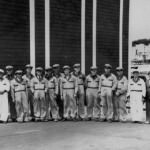 From July 1923 to November 1957, the Michigan State Car Ferry System served the Straits of Mackinac area. The Ferry Business Office remained – for all those years – on State Ferry Dock #1 (present site of Arnold Transit passenger operations). This photo (right) was taken near the end of State Ferry Dock #1; a uniformed ferry crew standing in front of the car loading elevator, circa 1930s.
From July 1923 to November 1957, the Michigan State Car Ferry System served the Straits of Mackinac area. The Ferry Business Office remained – for all those years – on State Ferry Dock #1 (present site of Arnold Transit passenger operations). This photo (right) was taken near the end of State Ferry Dock #1; a uniformed ferry crew standing in front of the car loading elevator, circa 1930s.
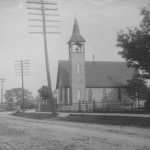 The Episcopal Church of the Good Shepherd was built in the third ward (site presently being used by St. Ignace Senior Housing) in 1883, because it was thought that the town center would be near the sawmill there. By 1890, the building had been moved south thru midtown and up the big hill to Prospect Street. This church, with various small alterations, was used into the 21st century,but is now a private home. The photo at left was taken circa 1900.
The Episcopal Church of the Good Shepherd was built in the third ward (site presently being used by St. Ignace Senior Housing) in 1883, because it was thought that the town center would be near the sawmill there. By 1890, the building had been moved south thru midtown and up the big hill to Prospect Street. This church, with various small alterations, was used into the 21st century,but is now a private home. The photo at left was taken circa 1900.
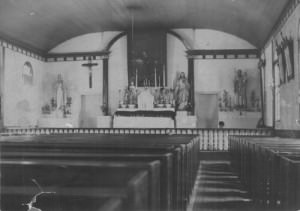 The Mission Church had a very basic exterior but was quite ornate inside. This church was deconsecrated when the congregation moved into the new church in 1904. It was then used as a novelty store, later becoming Cloverland Hall which was used for social gatherings. Years later, it was purchased by a parishioner, restored and gifted back to the church. After the Knights of Columbus moved it to the site of Father Marquette’s grave, it was used as a museum.
The Mission Church had a very basic exterior but was quite ornate inside. This church was deconsecrated when the congregation moved into the new church in 1904. It was then used as a novelty store, later becoming Cloverland Hall which was used for social gatherings. Years later, it was purchased by a parishioner, restored and gifted back to the church. After the Knights of Columbus moved it to the site of Father Marquette’s grave, it was used as a museum.
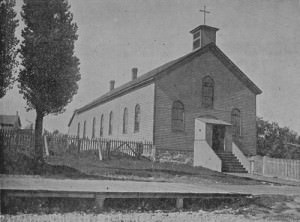 The Catholic congregation was housed in a log building which served during the occasional visits by the priest. In 1837, The Mission Church was built adjacent to the old log building and on the same site. Soon, a resident priest was assigned to the church at the (current) corner of South State and Truckey Streets. This church building served until 1904, when the new church, St. Ignatius Loyola was built at the corner of Spring and Church Streets.
The Catholic congregation was housed in a log building which served during the occasional visits by the priest. In 1837, The Mission Church was built adjacent to the old log building and on the same site. Soon, a resident priest was assigned to the church at the (current) corner of South State and Truckey Streets. This church building served until 1904, when the new church, St. Ignatius Loyola was built at the corner of Spring and Church Streets.
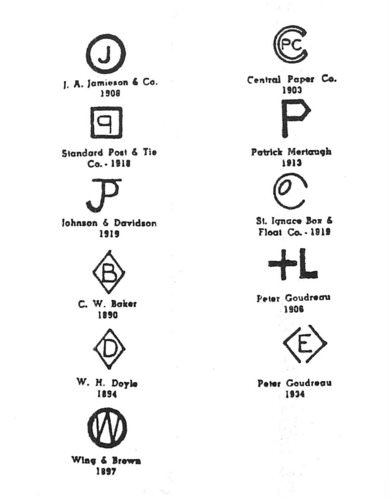 Most lumber cutting took place in the winter. Cut logs were transported to and piled on the shores of rivers and lakes to await the high, fast water from the springtime snowmelt. Logs from many timber companies mixed together and, once at the sawmill, had to be sorted as to their ownership. In 1842, to facilitate this sorting, state law required the timber companies to register their logmarks in the county where the wood was cut. The logs were “branded” -on their ends- by one blow of a heavy marking hammer, before the logs left the woods.
Most lumber cutting took place in the winter. Cut logs were transported to and piled on the shores of rivers and lakes to await the high, fast water from the springtime snowmelt. Logs from many timber companies mixed together and, once at the sawmill, had to be sorted as to their ownership. In 1842, to facilitate this sorting, state law required the timber companies to register their logmarks in the county where the wood was cut. The logs were “branded” -on their ends- by one blow of a heavy marking hammer, before the logs left the woods.
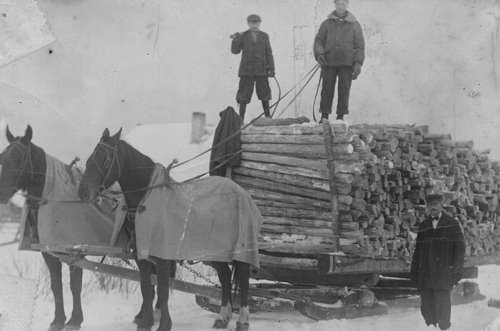 Besides the lumber for building and boat construction, ample wood resources created the opportunities for many other businesses in this area. There were several shingle mills and manufacturers of fishing net floats, fish boxes, barrrel staves, railroad ties, fence posts and those who provided cord wood for: steamship fuel, heating stoves and cooking ranges.
Besides the lumber for building and boat construction, ample wood resources created the opportunities for many other businesses in this area. There were several shingle mills and manufacturers of fishing net floats, fish boxes, barrrel staves, railroad ties, fence posts and those who provided cord wood for: steamship fuel, heating stoves and cooking ranges.
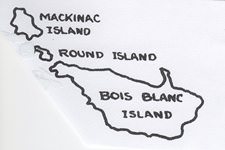 Tucked in between Mackinac and Bois Blanc Islands, tiny Round Island is only three miles in circumference. With its oil house and privy, the lighthouse is out on a northwest spit of land, while the remainder of the island is wooded. Now owned wholly by the U.S. government, it was once know as Middle Island (Nissawinagong).
Tucked in between Mackinac and Bois Blanc Islands, tiny Round Island is only three miles in circumference. With its oil house and privy, the lighthouse is out on a northwest spit of land, while the remainder of the island is wooded. Now owned wholly by the U.S. government, it was once know as Middle Island (Nissawinagong).
 A griffon is a mythological creature with a forepart of an eagle and the body of a lion. The first ship to sail the Great Lakes was built by LaSalle in the Niagara River and named for this fearsome beast. In 1679, Griffon came to St. Ignace on her first voyage, to pick up a wealth of furs. LaSalle sent her west to load more furs, while he traveled on foot. After loading at Green Bay, she and her crew sailed out of the harbor-never to be seen again! For more than three centuries, her wreck has been sought after-with no results.
A griffon is a mythological creature with a forepart of an eagle and the body of a lion. The first ship to sail the Great Lakes was built by LaSalle in the Niagara River and named for this fearsome beast. In 1679, Griffon came to St. Ignace on her first voyage, to pick up a wealth of furs. LaSalle sent her west to load more furs, while he traveled on foot. After loading at Green Bay, she and her crew sailed out of the harbor-never to be seen again! For more than three centuries, her wreck has been sought after-with no results.
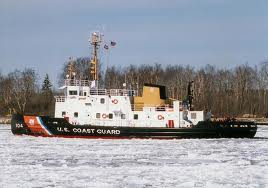 The United States Coast Guard Icebreaker Biscayne Bay (WTGB-104) was built at Tacoma, Washington in 1979. The 140-foot Bay Class Icebreaker has been homeported at St. Ignace all her life.
The United States Coast Guard Icebreaker Biscayne Bay (WTGB-104) was built at Tacoma, Washington in 1979. The 140-foot Bay Class Icebreaker has been homeported at St. Ignace all her life.
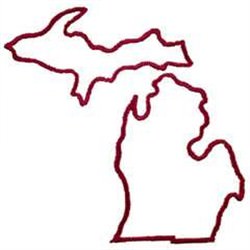 Michigan has more lighthouses than any other state. It has more miles of shoreline than all states but Alaska.
Michigan has more lighthouses than any other state. It has more miles of shoreline than all states but Alaska.
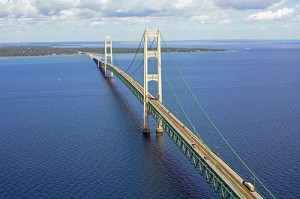 The only place where any of the five Great Lakes meet is where Lake Michigan and Lake Huron come together in the Straits of Mackinac. All others are divided by rivers.
The only place where any of the five Great Lakes meet is where Lake Michigan and Lake Huron come together in the Straits of Mackinac. All others are divided by rivers.
 St. Ignace’s great Ore Dock (to load iron ore from trains into ships) was built in 1881 and operated for only a short time. It featured an elevated approach from the Truckey Street area, across what is now known as State Street-just north of the Railroad Dock. Costing more than a half-million dollars, it eventually extended out into the water more than 600 feet.
St. Ignace’s great Ore Dock (to load iron ore from trains into ships) was built in 1881 and operated for only a short time. It featured an elevated approach from the Truckey Street area, across what is now known as State Street-just north of the Railroad Dock. Costing more than a half-million dollars, it eventually extended out into the water more than 600 feet.
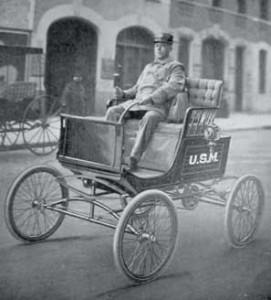 The story is told that the first horseless carriage reached St. Ignace in 1908, two years later the first automobile repair facility opened here. Wing’s Garage occupied the current Fort de Buade Museum building.
The story is told that the first horseless carriage reached St. Ignace in 1908, two years later the first automobile repair facility opened here. Wing’s Garage occupied the current Fort de Buade Museum building.
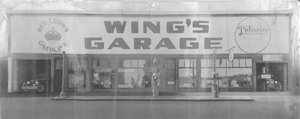
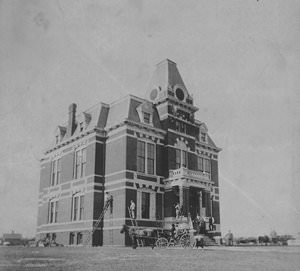 Mackinac County was set up as a judicial district in 1818. Judges traveled here from Washington, D.C. to hold court. The county seat was on Mackinac Island until voters decided to move it. In 1882, at a cost of $25,000, the first courthouse in St. Ignace was built.
Mackinac County was set up as a judicial district in 1818. Judges traveled here from Washington, D.C. to hold court. The county seat was on Mackinac Island until voters decided to move it. In 1882, at a cost of $25,000, the first courthouse in St. Ignace was built.
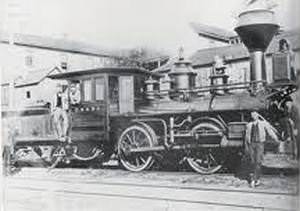 The first railroad arrived in St. Ignace in 1881. The Duluth, South Shore & Atlantic Railroad (DSS&A) connected freight and passenger service with points west across the Upper Peninsula and on into the western USA.
The first railroad arrived in St. Ignace in 1881. The Duluth, South Shore & Atlantic Railroad (DSS&A) connected freight and passenger service with points west across the Upper Peninsula and on into the western USA.
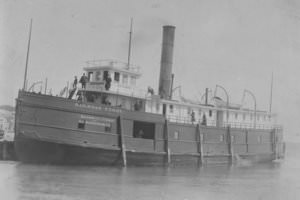 Soon after the DSS&A Railroad’s arrival in St. Ignace from the west, railroad service was initiated – by railroad ferry – across the Straits of Mackinac. The first railroad ferry, Algomah & her barge Betsy proved to be unsatisfactory. The barge was hard to control and not safe for passengers nor crew.
Soon after the DSS&A Railroad’s arrival in St. Ignace from the west, railroad service was initiated – by railroad ferry – across the Straits of Mackinac. The first railroad ferry, Algomah & her barge Betsy proved to be unsatisfactory. The barge was hard to control and not safe for passengers nor crew.
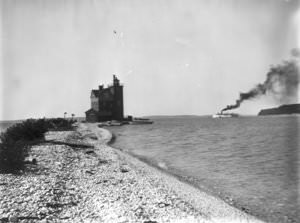 The first lighthouse visible from St. Ignace was on Round Island. Known as the Round Island Passage Lighthouse, it overlooks the commercial shipping channel between Round Island and Mackinac Island. Local contractor, Frank Rounds and his crew built it in 1895 for a cost of $15,000. Early on, it sported an all-red exterior, but now is a distinctive white-over-red with a red tower.
The first lighthouse visible from St. Ignace was on Round Island. Known as the Round Island Passage Lighthouse, it overlooks the commercial shipping channel between Round Island and Mackinac Island. Local contractor, Frank Rounds and his crew built it in 1895 for a cost of $15,000. Early on, it sported an all-red exterior, but now is a distinctive white-over-red with a red tower.
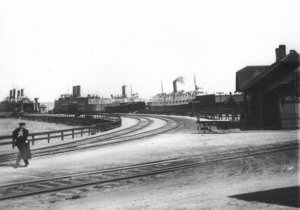 St. Ignace was a railroad hub-where ships and trains met. The area now occupied by Little Bear East Arena was formerly a railroad roundhouse and switchyard – the spot where rail cars were made into trains. These trains then traveled up the tracks heading northwest, to meet other rail traffic at Trout Lake.
St. Ignace was a railroad hub-where ships and trains met. The area now occupied by Little Bear East Arena was formerly a railroad roundhouse and switchyard – the spot where rail cars were made into trains. These trains then traveled up the tracks heading northwest, to meet other rail traffic at Trout Lake.
 Michigan was the first state to establish a state car ferry system. By late 1923, little Ariel was shuttling automobiles from St. Ignace’s State Dock (now Arnold Transit’s dock) across the Straits of Mackinac to the State Dock in Mackinaw City.
Michigan was the first state to establish a state car ferry system. By late 1923, little Ariel was shuttling automobiles from St. Ignace’s State Dock (now Arnold Transit’s dock) across the Straits of Mackinac to the State Dock in Mackinaw City.
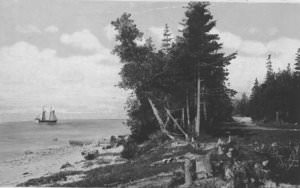 The southernmost portion of St. Ignace is now known as Graham’s Point, named for John Graham, an early settler who immigrated from Ireland in the very early 1800’s. Historically, it has also been called Pointe St. Ignace and Iroquois Point.
The southernmost portion of St. Ignace is now known as Graham’s Point, named for John Graham, an early settler who immigrated from Ireland in the very early 1800’s. Historically, it has also been called Pointe St. Ignace and Iroquois Point.
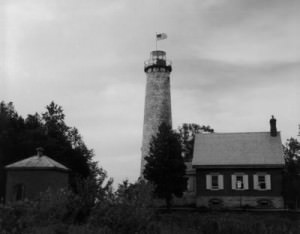 St. Helena Island received its lighthouse in 1873 and the lighthouse was automated in 1922. This lighthouse is the only remaining structure from the thriving 1800’s village located on the island. In recent years, boy scout troops have done many renovations and rebuilding of the lighthouse complex structures. They spend part of each summer there.
St. Helena Island received its lighthouse in 1873 and the lighthouse was automated in 1922. This lighthouse is the only remaining structure from the thriving 1800’s village located on the island. In recent years, boy scout troops have done many renovations and rebuilding of the lighthouse complex structures. They spend part of each summer there.
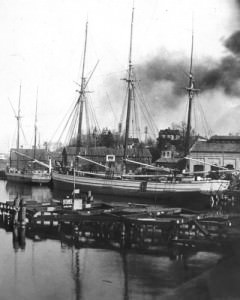 St. Helena Island, just west of the Mackinac Bridge, once hosted a thriving town. Then, the island was owned by the Newton brothers, Archie and Wilson. For 50+ years, the fine harbor served the shipping industry with firewood for steamships and freight to increase their profitability. At times, up to 100 ships were served per day.
St. Helena Island, just west of the Mackinac Bridge, once hosted a thriving town. Then, the island was owned by the Newton brothers, Archie and Wilson. For 50+ years, the fine harbor served the shipping industry with firewood for steamships and freight to increase their profitability. At times, up to 100 ships were served per day.
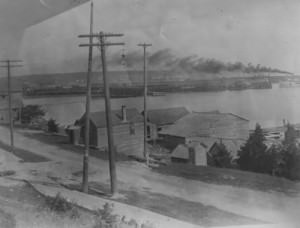 With Peter Hombach as its first postmaster,
With Peter Hombach as its first postmaster,
St. Ignace’s first U.S. Post Office was opened in November 1874. Folks picked up their own mail at the post office after it arrived on a boat from the south. Mail was carried from here to Sault Ste. Marie twice each week. Rural delivery routes were established in 1929 and city carrier service began in 1946.
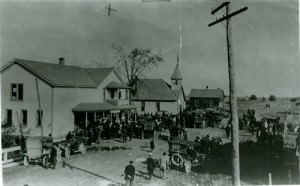 The Martel Furnace ran timber operations in Ozark and Allenville (northwest of St. Ignace) and fired seven kilns in that area. These kilns burned wood down into charcoal, which burns hotter in the smelting process. In Allenville, the company erected a boarding house and company store for the timber crews. The building was sold in 1893 and was put to use as a general store, hotel and post office. This building still stands next door to the old Grange Hall.
The Martel Furnace ran timber operations in Ozark and Allenville (northwest of St. Ignace) and fired seven kilns in that area. These kilns burned wood down into charcoal, which burns hotter in the smelting process. In Allenville, the company erected a boarding house and company store for the timber crews. The building was sold in 1893 and was put to use as a general store, hotel and post office. This building still stands next door to the old Grange Hall.
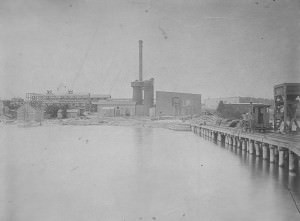 Martel Furnace was a charcoal-fired iron ore smelting furnace, located where the U.S. Coast Guard station is now. The company made a high-grade steel used for the manufacture of railroad car wheels. Operating from 1881, with its own railroad spur, company store and shipping dock, Martel was done in by the Financial Panic of 1893 and operated only fitfully thereafter for a few years. The furnace complex burned in 1903.
Martel Furnace was a charcoal-fired iron ore smelting furnace, located where the U.S. Coast Guard station is now. The company made a high-grade steel used for the manufacture of railroad car wheels. Operating from 1881, with its own railroad spur, company store and shipping dock, Martel was done in by the Financial Panic of 1893 and operated only fitfully thereafter for a few years. The furnace complex burned in 1903.
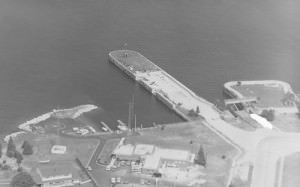 St. Ignace’s United States Coast Guard station is located on the former site of the Martel Furnace at the south end of town. Before 1966, the Coast Guard operated out of Mackinac Island. The station uses a variety of small craft to perform its duties of search and rescue, homeland security, maritime law enforcement and servicing aids-to-navigation.
St. Ignace’s United States Coast Guard station is located on the former site of the Martel Furnace at the south end of town. Before 1966, the Coast Guard operated out of Mackinac Island. The station uses a variety of small craft to perform its duties of search and rescue, homeland security, maritime law enforcement and servicing aids-to-navigation.
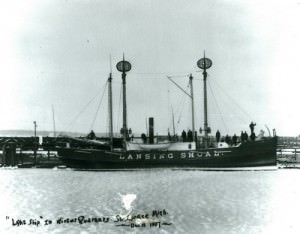 Some Great Lakes danger spots were deemed too inhospitable or too expensive for construction of a permanent lighthouse. So, lightships came into use. The lightship would be put into position seasonally and her crew came and went, while she held her vigil. Pictured here is the lightship for Lansing Shoal (she served from 1900 to 1920), in her 1907 winter mooring at St. Ignace.
Some Great Lakes danger spots were deemed too inhospitable or too expensive for construction of a permanent lighthouse. So, lightships came into use. The lightship would be put into position seasonally and her crew came and went, while she held her vigil. Pictured here is the lightship for Lansing Shoal (she served from 1900 to 1920), in her 1907 winter mooring at St. Ignace.
